SMART NEWS SCIENCE
Real planet discovered where vulcan home world in “star trek” is set.
“Fascinating, Captain”
/https://tf-cmsv2-smithsonianmag-media.s3.amazonaws.com/accounts/headshot/10172852_10152012979290896_320129237_n.jpg)
Katherine J. Wu
Correspondent
/https://tf-cmsv2-smithsonianmag-media.s3.amazonaws.com/filer/f2/02/f202b349-412b-481c-8ebc-6e22cfa54e04/vulcan_spock_1.jpg)
In the “Star Trek” universe, the star 40 Eridani A (alias HD 26965) has long been canon as the sun of Vulcan, the home world of the franchise’s favorite pointy-eared science officer, Mr. Spock.
This was first established in 1968 by James Blish’s script anthology S tar Trek 2 and later affirmed in 1980’s Star Trek Maps by Jeff Maynard. But it wasn’t until 1991 that show creator Gene Roddenberry himself (backed by a few astrophysicists) penned a letter in scientific support of 40 Eridani as a probable host for Vulcan viability. Nearly three decades later, a new discovery from the University of Florida delivers some serious vindication to the choice, revealing a real-life planet actually clocking in at coordinates eerily reminiscent of the fictional M-Class planet.
A group of astronomers led by University of Florida’s Jian Ge first visualized the Vulcan lookalike as part of Dharma Planet Survey, which is exploring some 150 very bright stars near our solar system. The discovery marks the project’s first detection of a “ super-Earth ,” classified as a planet between two and ten times as massive as our own. This new candidate boasts a radius twice the size of Earth’s, and has nearly nine times the mass.
But the new find may have the potential to support life—and it’s the “closest [known] super-Earth orbiting another Sun-like star,” says Ge in a University of Florida press release .
And what about that Sun-like star? Compared to our own Sun, 40 Eridani A is a little smaller and cooler. But though the two stars are separated by about 17 light-years , according to David Bressan at Forbes , they’re thought to be about the same age—4.6 billion years old. This longtime solar sustenance could reasonably give the “Vulcan” planet enough time to evolve complex life forms. What’s more, this new celestial body orbits 40 Eridani A in what’s called a habitable zone, or a region with temperatures that could theoretically permit the existence of liquid water—a key requirement to live long and prosper.
“HD 26965 may be an ideal host star for an advanced civilization,” says study author Tennessee State University astronomer Matthew Muterspaugh in the release.
That being said, the new super-Earth candidate isn’t quite a home away from home : at their behemoth size and mass, many super-Earths exhibit a much higher gravitational pull than we’re used to, making us feel several times heavier than we would here on Earth. To make matters worse, this newly detected planet’s perimeter of orbit around 40 Eridani A is tight: A year there would barely last 42 days, and at such close proximity to its star, inhabitants could be exposed to some pretty toasty temperatures.
There’s a debate raging among astrophysicists, too, about how livable super-Earths even are. Leading planetary scientists like Alessandro Morbidelli of the University of Nice, France, believe that many such super-Earths may be uninhabitable (though arguments have also been made to the contrary). However, given the loose definition for these planets, issuing a single blanket statement about super-Earth habitability would be highly illogical, to borrow the words of one esteemed science officer.
Sadly, the newly detected planet is unlikely to acquire the official “Vulcan” moniker anytime soon. As Alan Boyle at GeekWire reports , “Vulcan” has already been tossed around as a hypothetical planet once thought to exist within the orbit of Mercury, and the International Astronomical Union’s planet-naming system can be a little prickly about names that tread on intellectual property rights . In fact, Boyle reports, the IAU recently vetoed the name for one of Pluto’s moons.
But devoted Trekkers (many of whom are in the space business, themselves) may not be too bothered by that.
After all, as planetary scientist Jessie Christiansen of NASA, pointed out on Twitter, [the planet] “is not very much like the fictional Vulcan.” “But,” she continues, “it’s a planet orbiting the same star and planets often have planet siblings, so I’m excited for more!”
Indeed, as astrophysicist Andy Howell of the Las Cumbres Observatory noted on Twitter: “If you're going by the new movies’ Star Trek lore, the planet the @UF astronomers found in 40 Eridani A could be Delta Vega, as the writers put it so close to Vulcan that you could see Vulcan huge in the sky from the surface.” (That’s the planet Captain Kirk met Spock in the 2009 franchise revival.)
And, until proven otherwise, the planet remains potentially habitable, so for those hoping for a First Contact scenario, keep your eyes peeled to the sky.
According to “Star Trek” lore, after all, humans and Vulcans are scheduled to meet in the not-too-distant future of April 5, 2063.
Get the latest stories in your inbox every weekday.
/https://tf-cmsv2-smithsonianmag-media.s3.amazonaws.com/accounts/headshot/10172852_10152012979290896_320129237_n.jpg)
Katherine J. Wu | | READ MORE
Katherine J. Wu is a Boston-based science journalist and Story Collider senior producer whose work has appeared in National Geographic , Undark magazine, Popular Science and more. She holds a Ph.D. in Microbiology and Immunobiology from Harvard University, and was Smithsonian magazine's 2018 AAAS Mass Media Fellow.
Thank you for visiting nature.com. You are using a browser version with limited support for CSS. To obtain the best experience, we recommend you use a more up to date browser (or turn off compatibility mode in Internet Explorer). In the meantime, to ensure continued support, we are displaying the site without styles and JavaScript.
- View all journals
- Explore content
- About the journal
- Publish with us
- Sign up for alerts
- RESEARCH HIGHLIGHT
- 18 September 2018

The exoplanet that could be Spock’s home world
A newfound planet (artist’s impression, left) has the same galactic address as the fictional planet Vulcan, of Star Trek fame. Credit: University of Florida/Don Davis
Astronomers have discovered a planet twice the size of Earth orbiting the nearby star 40 Eridani — precisely where Star Trek character Spock’s home planet Vulcan supposedly lies.
Access options
Access Nature and 54 other Nature Portfolio journals
Get Nature+, our best-value online-access subscription
24,99 € / 30 days
cancel any time
Subscribe to this journal
Receive 51 print issues and online access
185,98 € per year
only 3,65 € per issue
Rent or buy this article
Prices vary by article type
Prices may be subject to local taxes which are calculated during checkout
Nature 561 , 437 (2018)
doi: https://doi.org/10.1038/d41586-018-06725-2
Mon. Not. R. Astron. Soc. (2018)
Download references
- Planetary science

The science of 3 Body Problem: what’s fact and what’s fiction?
News Q&A 30 APR 24

What China’s mission to collect rocks from the Moon’s far side could reveal
News 30 APR 24

China's Moon atlas is the most detailed ever made
News 25 APR 24
Faculty Positions in Neurobiology, Westlake University
We seek exceptional candidates to lead vigorous independent research programs working in any area of neurobiology.
Hangzhou, Zhejiang, China
School of Life Sciences, Westlake University
Seeking Global Talents, the International School of Medicine, Zhejiang University
Welcome to apply for all levels of professors based at the International School of Medicine, Zhejiang University.
Yiwu, Zhejiang, China
International School of Medicine, Zhejiang University
Assistant, Associate, or Full Professor
Athens, Georgia
University of Georgia
Associate Professor - Synthetic Biology
Position Summary We seek an Associate Professor in the department of Synthetic Biology (jcvi.org/research/synthetic-biology). We invite applicatio...
Rockville, Maryland
J. Craig Venter Institute
Associate or Senior Editor (microbial genetics, evolution, and epidemiology) Nature Communications
Job Title: Associate or Senior Editor (microbial genetics, evolution, and epidemiology), Nature Communications Locations: London, New York, Philade...
New York (US)
Springer Nature Ltd
Sign up for the Nature Briefing newsletter — what matters in science, free to your inbox daily.
Quick links
- Explore articles by subject
- Guide to authors
- Editorial policies
Sorry, Star Trek fans, the real planet Vulcan doesn’t exist
The earlier discovery of an exoplanet inspired by Star Trek turned out to be a false alarm.
By Briley Lewis | Published Mar 7, 2023 12:00 PM EST
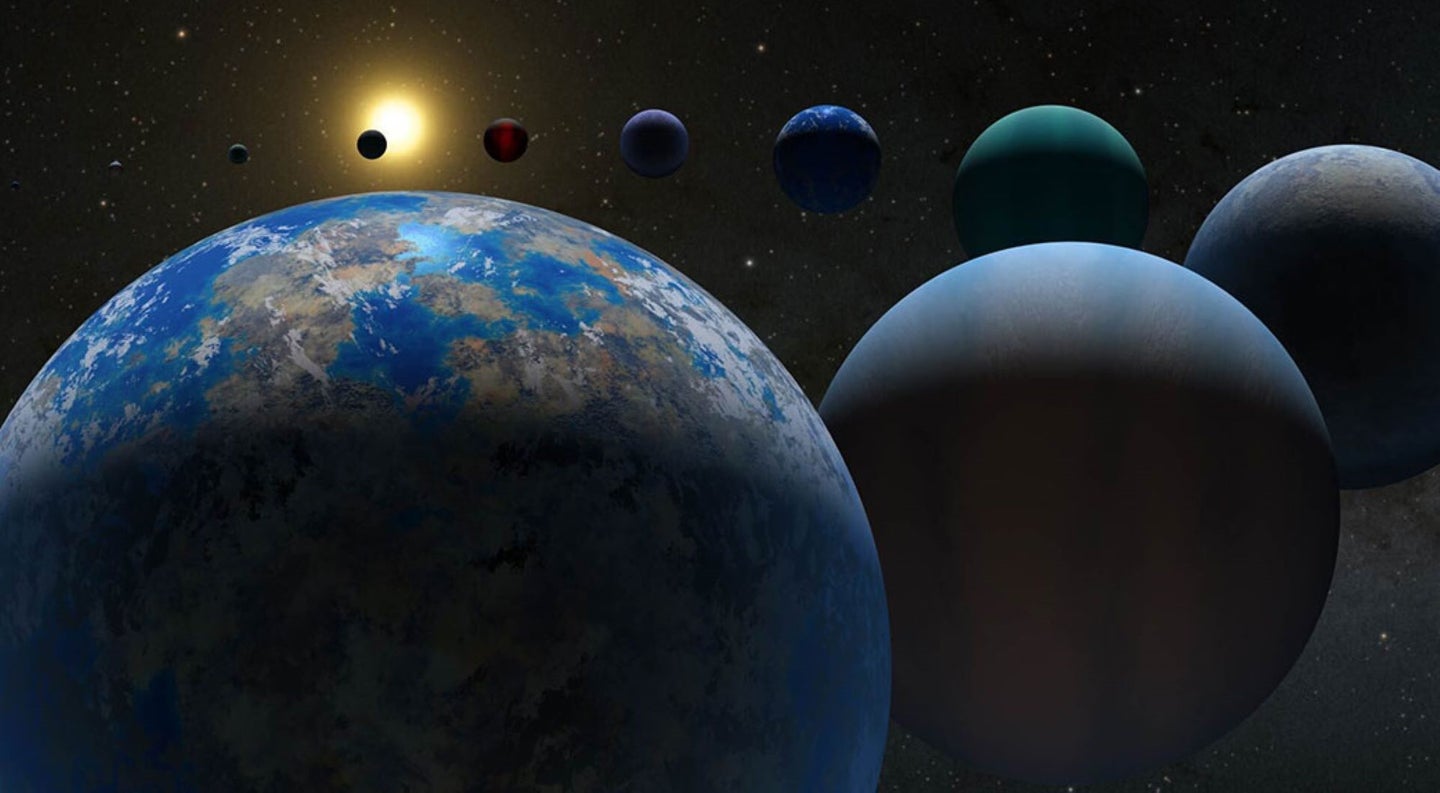
Star Trek fans knew they would lose the planet Vulcan someday in a fiery implosion at the hands of the Romulans—but they probably didn’t expect it to lose the planet in real life, too. Now reality is once again following fiction: The exoplanet once considered to be the real Vulcan has been erased, based on a new analysis of old data.
The 2018 discovery of the exoplanet known as 40 Eri b , which is located around the real-life star canonically orbited by Spock’s fictional homeworld, has turned out to be a false alarm. In a new research paper accepted for publication in the Astronomical Journal , astronomers used years of observations to re-analyze many previous exoplanet detections, including that of 40 Eri b. Unfortunately, astronomers hadn’t actually found Vulcan after all.
“As we continue to study objects with better and more precise instruments, reevaluating things we thought we already knew can lead to new conclusions about what’s really going on,” says Ohio State University astronomer Katherine Laliotis , lead author on the new work. In the case of 40 Eri b, the signal previously thought to be a planet turned out to be activity on the star’s surface. This work, she adds, is “a reminder that re-studying and reproducing already published results is a very valuable use of time.”
40 Eri b was originally detected using the radial velocity method , in which astronomers analyze the different wavelengths of light coming from a star. As a planet orbits a star, it’ll tug on its sun ever so slightly. When this tug pushes the star away from Earth, the star appears redder—thanks to the Doppler effect —and if it moves toward us, it appears bluer. With this method, astronomers believed they found 40 Eri b: A Neptune-sized planet 16 light-years away, so close to its star that a year would last only 42 days. This wouldn’t have been a particularly pleasant or habitable planet, but it made waves thanks to its sci-fi ties.
[Related: Newly discovered exoplanet may be a ‘Super Earth’ covered in water ]
Some astronomers, such as NASA astronomer Eric Mamajek , immediately expressed doubts about the supposed detection. That’s because the time it took for this planet to complete one orbit was suspiciously close to the time the star takes to rotate. His suspicions were right. By tracing a feature of the light spectrum known to be part of the star, Laliotis and collaborators confirmed the star’s rotation rate, marking the end of the possible planet 40 Eri b.
They didn’t specifically set out on a mission to kill Vulcan, though. This work was part of a bigger analysis, looking into all of NASA’s top picks for future exoplanet exploration—and 40 Eridani just happened to be on the list. Astronomers are always collecting new data, observing different stars, but “many planetary systems haven’t been officially updated since they were published in the early 2000s,” according to Laliotis.
Astronomers are already starting preparation for the next big space telescope, known as the Habitable Worlds Observatory . This future NASA mission aims to take photos of Earth-like planets around sun-like stars, allowing scientists to directly look into these exoplanets’ atmospheres for oxygen and other signs of life. Laliotis’s work fits right into this plan—she says this study aimed to figure out “what [planetary] systems we already understand well, what systems we have a misunderstanding of, and what systems need to be observed a lot more in the coming years.” This review will help make sure the future telescope’s precious observing time is used wisely.
“NASA is planning to spend billions of dollars on future missions to fly telescopes to study planets,” says Jessie Christiansen , project scientist at NASA’s Exoplanet Archive. “Imagine if this had been one of the targets! It’s not real!”
Although astronomers are, of course, glad to see rigorous scientific work being done, they’ll also admit that they are a bit sad about losing an exoplanet with such a cool sci-fi crossover. “I’m sad whenever any planet gets disproven, but this one hit especially hard because I’ve been using it for a few years now as a provocative, intriguing tie between the real worlds we’re discovering and the fictional worlds we know and love,” says Christiansen, who also started a lively Twitter conversation on the topic.
[Related: In a first, James Webb Space Telescope reveals distant gassy atmosphere is filled with carbon dioxide ]
This doesn’t completely rule out a real-world equivalent of Vulcan, though. The Neptune-sized planet discovered in 2018 isn’t there, but it’s possible a smaller planet—one we haven’t seen yet—still exists around the star 40 Eridani. With current technology and observations, astronomers simply can’t detect any planet smaller than 12 times Earth’s mass on an orbit similar to Earth’s. “This means there’s still a chance that Vulcan exists. In fact, there’s even a chance that Vulcan could be in the habitable zone for the star,” says Laliotis.
Even if Vulcan is gone for now, Trekkie astronomers will still find ways to have fun with sci-fi and outer space. “There are still many other planets in the Star Trek universe that haven’t been disproven,” adds Louisiana State University astronomer Alison Crisp . One potential planet orbiting Wolf 359 , for example, could still exist—the site of a major Star Trek battle.
UCLA astronomer Isabella Trierweiler actually sees a way this saga fits into Star Trek canon. “Until 2063, Vulcans are just observing Earth and waiting for us to develop warp capabilities,” Trierweiler says. “Maybe they were able to adjust our observations to hide the planet, maybe they found super strong cloaking devices, or maybe Vulcan was briefly one of those planets that phases in and out of dimensions!” Whatever Vulcan’s fate, humanity has a few more years of technological development ahead of us until we reach these sci-fi dreams. And perhaps those lofty goals will help us find a real planet around 40 Eridani.
Like science, tech, and DIY projects?
Sign up to receive Popular Science's emails and get the highlights.
Sorry, Spock, but planet Vulcan's real-life doppelgänger doesn't exist
What was thought to be a real-life analog for the planet Vulcan doesn't exist.
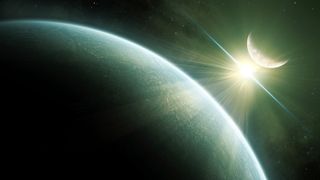
This is going to disappoint Trekkies everywhere, but what was thought to be a real-life version of the exoplanet Spock calls home is actually not a planet at all.
Vulcan (for the uninitiated) is the planet in the " Star Trek " universe which orbits the actual star 40 Eridani A in the constellation of Eridanus . When a research team thought they had discovered a real-life version of that planet , 40 Eri b, in 2018, it thrilled the entire fandom.
Now a new study that reexamined exoplanet candidates has disproved that planet's existence. Unfortunately, the gravitational pull thought to be exerted by the planet was really just caused by the star's surface acting up.
"We present strong evidence that the planet HD26965 b ( o 2 Eri b, 40 Eri b) reported [in 2018] is not a planet, and is rather caused by stellar activity," the researchers wrote in a new study .
Related: Hey, Spock! Real-Life 'Planet Vulcan' Orbits Sun Featured in 'Star Trek'
"Vulcan" was previously thought to exist because of signals from 40 Eridani A that were discovered using the radial velocity method . Stars and planets exert gravity on each other. When an object is gravitationally pulled to move towards an observer, its light shifts to the bluer side of the spectrum (blueshift), and to the redder side of the spectrum (redshift) when it is moving away from the observer. Exoplanets cannot be directly seen this way, but detected because of the way their gravity makes the star move.
40 Eridani A seemed to have an orbiting planet because of consistent signals from its motion. It sounds, as Spock would say, perfectly logical.
Get the Space.com Newsletter
Breaking space news, the latest updates on rocket launches, skywatching events and more!
There are issues with the radial velocity method, though. It has more success detecting large exoplanets that orbit close to their star as opposed to smaller exoplanets and planets orbiting further away. At about twice the size of Earth — a " super-Earth " — the hypothetical 40 Eri b was on the smaller side. Its assumed orbit was even in the habitable 'Goldilocks' zone .
When the signals that appeared to give away a planet were analyzed again, because NASA needs a heads up before investing in closer studies of candidate exoplanets, they were outed as a false positive. Vulcan's entire existence was pushed back into the realm of science fiction.

— Why are there so few 'hot Neptune' exoplanets?
— Elusive Planet Nine could be surrounded by hot moons, and that's how we'd find it
— Massive 'forbidden planet' orbits a strangely tiny star only 4 times its size
If the Vulcan analog was real, it would have been a prime subject to observe not only because of its supposed location in the habitable zone, but because its star is similar to our sun. There would have been at least a possibility for some sort of life. In their 2018 statement , the researchers who thought they had detected the fictional planet even suggested an advanced civilization like the Vulcans could thrive near its star.
Does this mean nothing is orbiting 40 Eridani A? Maybe there is a smaller or further planet somewhere, but for now, no more are suspected. Something could come up in the future. Until then, live long and prosper, fictional planet Vulcan.
The research is described in a paper accepted for publication in The Astronomical Journal and posted on the preprint server arXiv .
Follow us @Spacedotcom , or on Facebook and Instagram .
Join our Space Forums to keep talking space on the latest missions, night sky and more! And if you have a news tip, correction or comment, let us know at: [email protected].
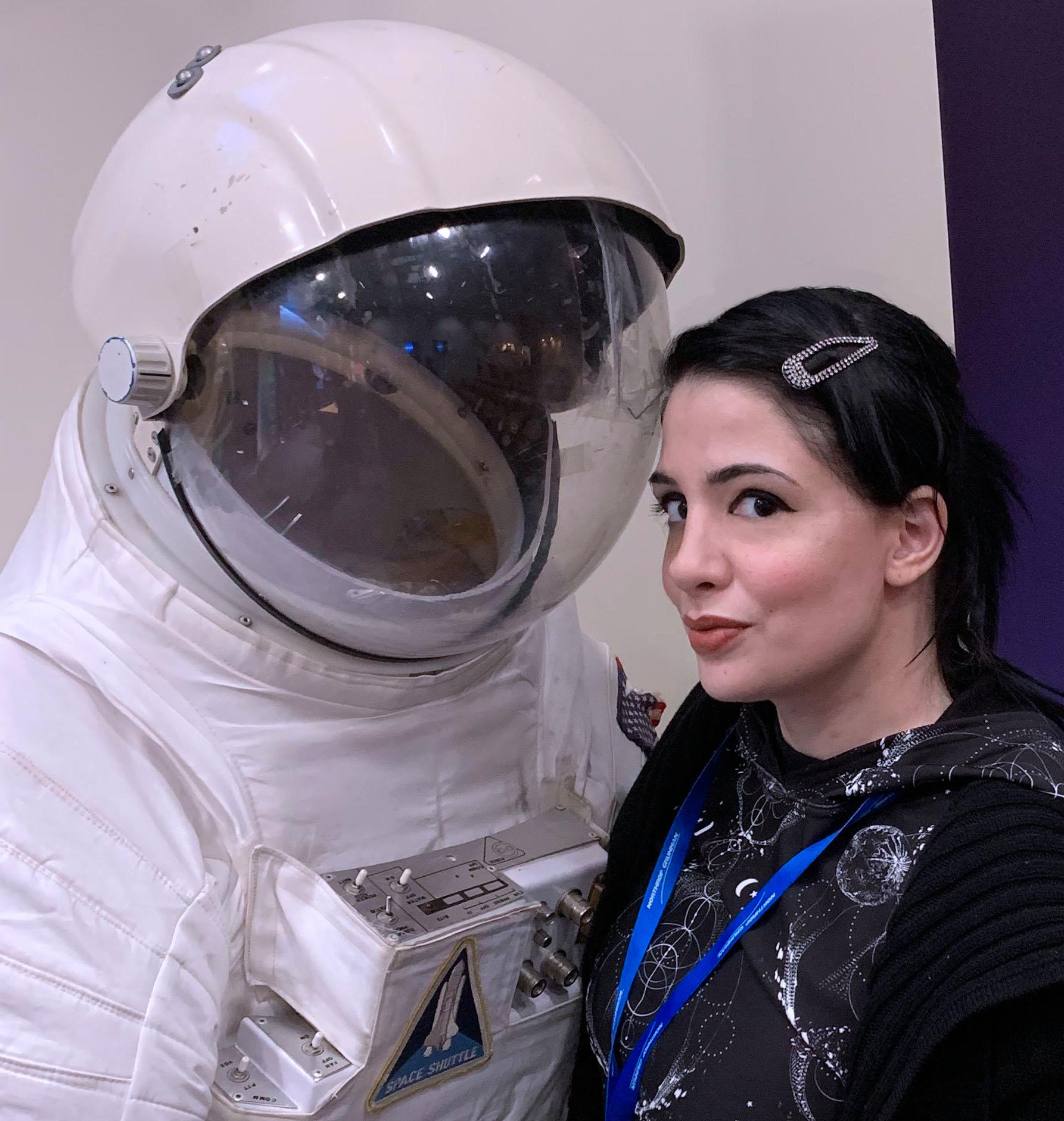
A Switzerland-size hole opened in Antarctica's sea ice in 2016-17. Now we know why
China to launch sample-return mission to the moon's far side on May 3
Curious asteroid Selam, spotted by NASA's Lucy spacecraft, is a cosmic toddler
Most Popular
- 2 Astronauts on the moon could stay fit by running in a Wheel of Death
- 3 Watch live: China launching Chang'e 6 mission to far side of the moon early May 3 (video)
- 4 Watch ULA assemble Atlas V rocket ahead of Boeing Starliner astronaut test flight (video)
- 5 NASA's Hubble Telescope is back in action — but its TESS exoplanet hunter may now be in trouble
Greetings From Vulcan? Planet Discovered Orbiting the Star of Spock's Homeworld in "Star Trek"
Astronomers find an exoplanet around the same star that Vulcan orbits in Star Trek canon.

In 1991, Gene Roddenberry wrote a letter to Sky & Telescope about what kind of star the planet Vulcan was likely to orbit. In that letter, he specifically picks out one such star, 40 Eridani. Later, 40 Eridani became the canon Vulcan star system featured in a handful of episodes of Star Trek: Enterprise .
In real life, 40 Eridani is a triple star system located about 17 light-years from the Earth. The main star, 40 Eridani A, is about 84 percent as massive as our sun. The other two stars in the system are much smaller and orbit 10 times as far away from the main star as Pluto orbits from the sun.
While 40 Eridani isn’t the largest or brightest star in the night sky, it is pretty close to us, making it a good target for scientists searching for planets around other stars. Recently, a group of scientists at the Fairborn Observatory working with the Dharma Planet Survey took a good look at 40 Eridani and discovered a planet circling it , just like Gene Roddenberry said it would.
The newly discovered planet probably doesn’t have logical residents with pointy ears. What we do know is that it is about twice the size of the Earth and orbits its host star once every 42 days. Such a short orbital period means that this planet is located very close to its star, making it hot and dry. In fact, it’s unlikely to have any kind of life living on it at all.
This also makes this newly-discovered planet the first ever found by the Dharma Planet Survey, which is designed to hunt planets around nearby stars. With any luck, this will only be the first of many.
Source: Monthly Notices of The Royal Astronomical Society via Space.com

.css-cuqpxl:before{padding-right:0.3125rem;content:'//';display:inline;} Deep Space .css-xtujxj:before{padding-left:0.3125rem;content:'//';display:inline;}

Astronomers Found a ‘Sleeping Giant’ Black Hole

Similar Planets Could Point Toward Alien Worlds

We May Be Living in a Variable Universe

The Universe Could Be Eternal, This Theory Says

Fugitive Stars Are Heading to Our Galaxy
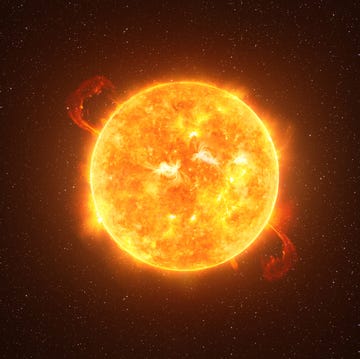
A Giant Star Looks Like It's Defying Astrophysics

Meteorite Strike Was Actually Just a Truck
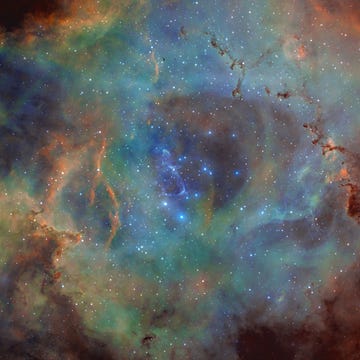
Theory Says Our Universe Is Eating Baby Universes

Astronomers Caught Dark Matter in the Cosmic Web
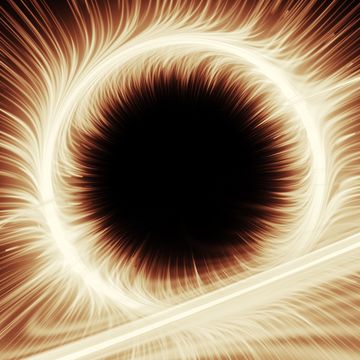
A Study Says Black Holes Can Create Space Lasers
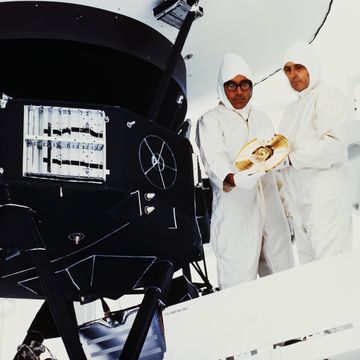
Voyager 1 Has Gone Silent in Deep Space
share this!
March 8, 2023 report
This article has been reviewed according to Science X's editorial process and policies . Editors have highlighted the following attributes while ensuring the content's credibility:
fact-checked
trusted source
Star Trek's planet Vulcan found to not be a planet after all
by Bob Yirka , Phys.org

A large international team of space scientists has discovered that the detection of an exoplanet orbiting the star 40 Eridani was made in error. The group has published a paper on the arXiv pre-print server describing their reanalysis of the star and its exoplanet and how they discovered the error.
Back in 1966, the television show "Star Trek" made its debut—it lasted all of three years, but made an indelible impression on the American psyche. Several spin-offs have been made along with several motion pictures . One of the main characters was an alien named Spock, who hailed from the planet Vulcan, which orbited a star called 40 Eridani A.
That star and its fictional planet were based on the real star 40 Eridani A and a presumed exoplanet . In 2018, an exoplanet was discovered orbiting 40 Eridani A—it was named 40 Eri b, though many "Star Trek" fans no doubt wanted it to be named Vulcan. Unfortunately, it turns out that 40 Eri b does not really exist—the discovery was a mistake.
In this new effort, the researchers were working their way through a list of exoplanets that NASA is considering for closer study to make sure they are worthy of the huge costs involved. But in taking a closer look at 40 Eri b, they found some problems.
Such problems were not wholly unexpected. Some astronomers had questioned whether 40 Eri b, was actually a planet shortly after it was discovered. This was because it seemed unlikely that the duration of one orbit would be the same as the duration of one star rotation.
40 Eri b was thought to be a planet based on an analysis using radial velocity to study the wavelengths of light emitted from 40 Eridani. The team observed what they thought was a gravitational tug on the star, indicating pull from an exoplanet. But in tracing features of the light spectrum from the star, the new team found that the pull that had been observed was actually due to activity on the surface of the star—not evidence of an exoplanet.
Journal information: arXiv
© 2023 Science X Network
Explore further
Feedback to editors

Nanotech opens door to future of insulin medication
19 hours ago

How evolving landscapes impacted First Peoples' early migration patterns into Australia
22 hours ago

Saturday Citations: Parrots on the internet; a map of human wakefulness; the most useless rare-earth element
23 hours ago

When injecting pure spin into chiral materials, direction matters
May 4, 2024

New quantum sensing scheme could lead to enhanced high-precision nanoscopic techniques

Boeing's Starliner finally ready for first crewed mission

Hungry, hungry white dwarfs: Solving the puzzle of stellar metal pollution
May 3, 2024

How E. coli get the power to cause urinary tract infections

Male or female? Scientists discover the genetic mechanism that determines sex development in butterflies

New study is first to use statistical physics to corroborate 1940s social balance theory
Relevant physicsforums posts, retro/prograde flyby galaxies and its bar formation..
3 hours ago
Asteroid 2024 BX1 entered Earth's atmosphere over Germany 21 Jan 2024
21 hours ago
Our Beautiful Universe - Photos and Videos
Solar activity and space weather update thread, documenting the setup of my new telescope, solar wind particles, - reaching into earth's magnetic field.
May 1, 2024
More from Astronomy and Astrophysics
Related Stories

Newly discovered planet could be Spock's home world, astronomers say
Sep 19, 2018

Earth-sized planet found just 72 light years away
Feb 6, 2023

Astronomers detect new Jupiter-like exoplanet
Nov 23, 2022

Two Earth-mass exoplanets orbiting nearby star discovered
Dec 21, 2022

An ultra-short-period exoplanet discovered with TESS
Nov 24, 2022

Planet spiralling into star may offer glimpse into Earth's end
Dec 24, 2022
Recommended for you

Astronomers inspect population of young stellar objects in open cluster NGC 346

TOI-837 b is a young Saturn-sized exoplanet with a massive core, observations find
May 2, 2024

Webb telescope probably didn't find life on an exoplanet—yet

X-ray satellite XMM-Newton sees 'space clover' in a new light

A 'cosmic glitch' in gravity: New model may explain strange behavior on a cosmic scale
Let us know if there is a problem with our content.
Use this form if you have come across a typo, inaccuracy or would like to send an edit request for the content on this page. For general inquiries, please use our contact form . For general feedback, use the public comments section below (please adhere to guidelines ).
Please select the most appropriate category to facilitate processing of your request
Thank you for taking time to provide your feedback to the editors.
Your feedback is important to us. However, we do not guarantee individual replies due to the high volume of messages.
E-mail the story
Your email address is used only to let the recipient know who sent the email. Neither your address nor the recipient's address will be used for any other purpose. The information you enter will appear in your e-mail message and is not retained by Phys.org in any form.
Newsletter sign up
Get weekly and/or daily updates delivered to your inbox. You can unsubscribe at any time and we'll never share your details to third parties.
More information Privacy policy
Donate and enjoy an ad-free experience
We keep our content available to everyone. Consider supporting Science X's mission by getting a premium account.
E-mail newsletter

Memory Beta, non-canon Star Trek Wiki
A friendly reminder regarding spoilers ! At present the expanded Trek universe is in a period of major upheaval with the continuations of Discovery and Prodigy , the advent of new eras in gaming with the Star Trek Adventures RPG , Star Trek: Infinite and Star Trek Online , as well as other post-57th Anniversary publications such as the ongoing IDW Star Trek comic and spin-off Star Trek: Defiant . Therefore, please be courteous to other users who may not be aware of current developments by using the {{ spoiler }}, {{ spoilers }} OR {{ majorspoiler }} tags when adding new information from sources less than six months old (even if it is minor info). Also, please do not include details in the summary bar when editing pages and do not anticipate making additions relating to sources not yet in release. THANK YOU
- Memory Beta articles sourced from novels
- Memory Beta articles sourced from episodes and movies
- Memory Beta pages needing citation
- Memory Beta articles sourced from comics
- Memory Beta articles sourced from short stories
- Memory Beta articles sourced from novelizations
- Memory Beta articles sourced from video games
- Memory Beta articles sourced from Star Trek Online
- Beta Quadrant planets
- Federation worlds
- Planets attacked by the Borg (2381)
- Confederacy of Vulcan
- Second planets
- Vulcan system
- Vulcan sector planets
- Vulcan worlds
- View history
Ni'Var (also known as Vulcan / Vulcanis A II , Nevasa II or 40 Eridani A II ) is a planet , the second planet in the 40 Eridani star system , in orbit of the star 40 Eridani A . A class M desert planet, Vulcan is inhabited by the Vulcan civilization , who refer to their world as T'Khasi , Minshara or Ti-Valka'ain .
- 1.1 Astrometrics
- 1.2 Environment
- 1.3 History
- 1.4.1 Continents and provinces
- 1.4.2 Bodies of water
- 1.4.3 Mountains and volcanos
- 1.4.4 Other regions
- 1.4.5.1 Cities
- 1.4.5.2 Other locations
- 1.5.1 Flora
- 1.5.2 Fauna
- 1.6 Alternate realities
- 2.1 Connections
- 2.2.1 Appearances
- 2.2.2 References
- 2.3 External links
History and specifics [ ]
As the Vulcan homeworld , Vulcan was the capital planet of the Confederacy of Vulcan , and a founding world in both the Coalition of Planets and United Federation of Planets . ( Last Unicorn RPG modules : The Way of Kolinahr , Planets of the UFP ; Decipher RPG module : Aliens ; ST references : Star Charts , The Worlds of the Federation ; ENT novel : Kobayashi Maru )
Following the Romulan Supernova of 2387 and prior to the 32nd century , Romulans settled on the planet after the successul Reunification . The joined inhabitants renamed their world to Ni'Var . ( DSC episode : " Unification III ")
This world is known as vulqan to speakers of Klingonese . ( ST reference : The Klingon Dictionary )
Astrometrics [ ]
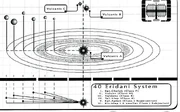
The Vulcan star system .
Vulcan orbits 40 Eridani A , known as Nevasa to the Vulcans, the primary orange K class star in the trinary Vulcan system . The other two stars in the system, 40 Eridani B and C , blue and red dwarfs respectively, co-orbited the A star at some distance and were not immediately visible in the Vulcan sky. ( ST references : The Worlds of the Federation , Star Charts ; TOS - Vulcan's Soul novel : Exodus ; Decipher RPG module : Aliens )
Vulcan's orbital period (year) is 203 days long. [ citation needed ] According to another source, Vulcan has an orbital radius of 0.56 AU , giving it a period of 177.6 standard days. However, the Vulcan calendar has set the Vulcan year to be about 1.5 times that, or 266.4 standard days. ( DTI novel : Watching the Clock )
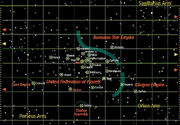
Vulcan vicinity.
Vulcan has no moon, but did have a number of nearby planets, most notably T'Khut , with which it shares an orbit around a common center of gravity; the two worlds were a mere 149,895.3579 kilometers apart, and T'Khut would fill the sky of the single hemisphere of Vulcan it was visible from due to the planets being tidally locked. ( TOS episode : " The Man Trap "; ST reference : The Worlds of the Federation ; TOS novel : Sarek )
T'Khut itself does have a moon, called T'Rukhemai , home of the Vulcanis Lunar Colony . ( TOS novel : Sarek ; VOY episode : " Unimatrix Zero "; VOY novel : Pathways )
Also passing near enough in its orbit that Vulcan can be clearly seen in the sky was the icy planet Delta Vega . ( TOS movie : Star Trek ; TOS comic : " Nero, Number Four ")
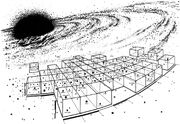
Vulcan on the explored galaxy map.
Vulcan was noted on star charts of the galaxy 's explored regions in the 23rd and 24th centuries , in an area of the projection also containing Sirius , Altair VI and Aldeberan . ( TOS movie : The Undiscovered Country , TNG episodes : " Conspiracy ", " The Measure of a Man ", " The Emissary ", " The Mind's Eye ", " The Game ", DS9 episodes : " In the Hands of the Prophets ", " Cardassians ")
Environment [ ]
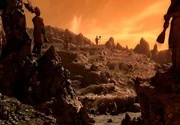
Vulcan's Forge , circa 2137 .
Vulcan is a harsh, desert planet with barely a quarter of its surface area containing water. It possesses a thin atmosphere and high gravity (1.4 G). ( Decipher RPG module : Aliens ) Furthermore, solar radiation is noted to be much higher when compared to other M-class planets such as Earth. ( TOS novel : Captain's Glory )
Vulcan has three primary continents called Na'nam , Han-shir and Xir'tan . The first are enormous land masses that were divided into various provinces while the third was an island somewhat larger than the Earth continent of Australia . ( Last Unicorn RPG module : The Way of Kolinahr: The Vulcans ) Due to the strong tidal forces brought about by the planet's interaction with T'Khut Vulcan was highly volcanically active. This generates a number of impressive lava spectacles, such as the Fire Plains . ( ST - New Worlds, New Civilizations short story : " Tempered by the Forge "; ENT episode : " Home ") Around four to five billion years ago, Vulcan was a highly geologically active environment. ( TOS novel : Firestorm )
Furthermore, there are frequent energy discharges in the air that shimmered in the red sky in a region near the Gateway where there was an area that had a distorted magnetic field as a result of Vulcan's ancient atomic wars. This serves as a form of third magnetic pole that disrupted most electrical as well as transtator currents in the region that are instead absorbed energy leak out into the wind. This is responsible for creating the spectacular lightning displays that are often seen in the clouds of sand. ( TOS novel : Captain's Glory )
Vulcan's geology and desert environment produce starkly up-thrust craggy and inhospitable mountains, with jagged and steep formations cut out by wind swept sand. ( Decipher RPG modules : Aliens , Worlds )
Vulcan maintains the oxygen in its atmosphere by deriving phytoplankton from its oceans, which existed as microscopic organisms that make up 90% of all planetary oxygenation processes, including those of Earth . Despite being a desert planet and not having a suitable source of oxygen in viable plant-life throughout most of their year, there is a sufficient amount of oxygenation occurring within the environment from the microbic water. [ citation needed ]
History [ ]
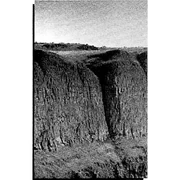
Vulcan's surface.
Though a dry desert occupied 96% of the planet's surface by the 23rd century , fossil records indicated that early Vulcan possessed 90% water along with a few islands with nothing but a hot sea present on the planet. Thousands of years later, when the proto-Vulcans developed and began to form tribes, 40 Eridani A erupted a massive solar flare that scorched the planet's surface; resulting in many native creatures dying, those which survived taking shelter in caves or other safe places on the opposite end of the planet. ( TOS novel : Spock's World )
Early in the Dominion War , Benjamin Sisko expressed his concerns to Admiral Zach Warner that the Dominion would eventually be able to invade Vulcan if Starfleet kept up its defense posture. The routes between Vulcan and Earth and Alpha Centauri were critical to the Federation. ( DS9 novelizations : Call to Arms... , ...Sacrifice of Angels ) The concerns for Vulcan lasted throughout the year, with fighting near the Vulcan border. Later, the fall of Betazed made the possibility of an invasion of Vulcan very likely. ( DS9 episodes : " Favor the Bold ", " In the Pale Moonlight ", " The Reckoning ")
During the Borg Invasion of 2381 , several Borg cubes moved to attack Vulcan. They managed to begin an orbital bombardment which inflicted severe damage to notable locations on the planet, including the Vulcan's Forge. However, the planet was saved from destruction when former Earth Captain Erika Hernandez managed to influence the collective to attack itself, severely damaging the cubes attacking Vulcan, which were later destroyed by a Starfleet task force including the USS Atlas and USS Prometheus . ( ST - Destiny novel : Lost Souls )
In 2468 of a timeline where the Federation chose not to intervene in the fight between the Borg and Cybermen , the Cybermen invaded Vulcan. Using his TARDIS , The Doctor and Jean-Luc Picard from 2368 witnessed these events. ( TNG comic : " Assimilation², Issue 5 ")
Eventually, the Vulcans allowed the Romulans to return to their ancestral home. Eventually, they were able to share their planet and eventually rename it Ni'Var. ( DSC episode : " Unification III ")
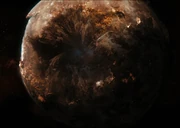
Destruction of Vulcan.
Geography [ ]

Continents and provinces [ ]
- Kel Province
- Gol • Khomi • Kir • Raal • Shi'al • Tat'Sahr
Bodies of water [ ]
Mountains and volcanos [ ], other regions [ ], vulcan settlements [ ].
Typically, there are no lost civilizations on the planet as new cities were always integrated into the older ones which meant that ruins remained. In addition, the planet's manufacturing and heavy industry has, for centuries, been conducted in the asteroid belt within the system. The only industry that was allowed on the surface were those that neither despoiled the environment nor disturbed its tranquility such as music crafting. ( TOS novel : Dwellers in the Crucible )
The Vulcan population was approximately 4.9 billion in the year 2378 . ( ST reference : Star Charts )
Other locations [ ]
Natural history [ ].
The heat of Vulcan's summer often kills off most vegetation, with plant life only flourishing once the rains come. In times of drought, out in the desert carnivorous plants are able to survive by catching any animal weakened by thirst. ( TOS novel : The Vulcan Academy Murders )
Alternate realities [ ]
In an alternate timeline in which Khan Noonien Singh won the Eugenics Wars and Humanity underwent genetic engineering en masse, the Khanate of Earth conquered Vulcan during the 21st century . The Vulcan government's unconditional surrender was presented to Khan in the rubble of the temple atop of Mount Seleya . The Vulcans remained helots of Humans well into the 24th century . ( DS9 - Myriad Universes novel : Seeds of Dissent )
In the alternate timeline created by Nero 's temporal incursion , Vulcan was destroyed in the year 2258 . The planet was obliterated by an artificial singularity created when Nero launched a red matter device into the planet's core. Of a population of 6 billion, approximately ten thousand escaped the devastation, and though their cultural legacy would survive, the Vulcan people became an endangered species. ( TOS movie & novelization : Star Trek )
Appendices [ ]
Connections [ ], appearances and references [ ], appearances [ ], references [ ].
- Last Unicorn RPG module : Raiders, Renegades & Rogues
- FASA RPG module : Trader Captains and Merchant Princes, 1st edition
- ST video game : Klingon Academy
- ST video game : Infinite
External links [ ]
- Ni'Var article at Memory Alpha , the wiki for canon Star Trek .
- Ni'Var article at STO Wiki , the FANDOM wiki for Star Trek Online .
- 1 Ferengi Rules of Acquisition
- 3 Odyssey class
Screen Rant
8 planets star trek destroyed.
The Star Trek franchise may not have a planet-destroying Death Star, but entire worlds being annihilated in Star Trek is still surprisingly common.
- Destruction isn't reserved for Death Stars - Star Trek has seen its fair share of planets obliterated.
- Movie scale allows for larger destruction - JJ Abrams' version famously took out Romulus and Vulcan.
- Planets lost in the storyline - from Xindus to Ceti Alpha VI, key planets have been lost in battle.
Star Trek may not have a Death Star, but that doesn't mean the franchise hasn't destroyed its fair share of planets over the years. Since its beginning with Star Trek: The Original Series in 1966, Star Trek has depicted an optimistic view of the future where humanity's main goal is exploration. Despite this, the United Federation of Planets has still made enemies who have managed to get their hands on powerful, planet-destroying weapons. A few Star Trek planets have also been accidentally destroyed by weapons or anomalies created for a different purpose altogether.
Many of Star Trek's most devastating moments of destruction happen in the Star Trek movies , as the scale for those stories is often larger than the television series can accommodate. J.J. Abrams' Star Trek (2009) famously destroyed Romulus and Vulcan, altering the trajectory of the Federation's future and the lives of Captain James Kirk (Chris Pine) and Spock (Zachary Quinto) in the alternate Kelvin timeline. However, these were not the first planets Star Trek destroyed. William Shatner's Captain Kirk and Leonard Nimoy's Spock were the first to encounter a "machine" capable of annihilating entire planets in the classic Star Trek: The Original Series episode "The Doomsday Machine."
Every Upcoming Star Trek Movie & TV Show
8 all seven planets in system l-370, destroyed in 2267 in star trek: the original series season 2, episode 6 - "the doomsday machine", star trek: the original series.
When the USS Enterprise responds to a distress call from their sister ship, the USS Constellation, they find the heavily damaged ship with only one passenger still alive, Commodore Matt Decker (William Windom) . The emotionally compromised Decker explains that his starship encountered a massive 'planet-killer' machine with the ability to destroy planets. The Constellation tried to attack the machine, but they were ineffective, and the Constitution Class starship sustained significant damage.
Commodore Decker beamed the USS Constellation's entire crew down to a nearby planet to keep them safe, but the machine then destroyed the planet, killing all of the Constellation's crew. The insane Decker steals a shuttle from the Starship Enterprise for a suicide run into the mouth of the machine. Although his attack causes only minor damage, it gives Captain Kirk the idea to send the Constellation into the robot, where it explodes and disables the planet-killer.
Destroyed in 2033, prior to Star Trek: Enterprise
Star trek: enterprise.
Located in the Delphic Expanse, the Xindi homeworld, Xindus, was already geologically unstable before it was destroyed during the Xindi Civil War. Prior to its destruction, Xindus was home to six different Xindi species, who were often in conflict with one another. At the height of their Civil War, the Xindi-Reptilians and Insectoids set off a massive bomb that destroyed the planet and wiped out the Xindi-Avians.
The remaining five species then spread out across the Delphic Expanse during a time that became known as the Great Diaspora . It was later that the transdimensional beings called the Guardians contacted the Xindi and told them that humanity would attack and destroy their future homeworld. This led the Xindi to launch a devastating attack on Earth in 2153, after which Captain Jonathan Archer (Scott Bakula) and the Enterprise NX-01 were sent into the Delphic Expanse.
6 Ceti Alpha VI
Destroyed in 2267, prior to star trek ii: the wrath of khan.
In Star Trek: The Original Series season 1, episode 22, "Space Seed," Captain Kirk encountered former Earth tyrant Khan Noonien Singh (Ricardo Montalban) for the first time. After Khan tries (and fails) to destroy the Enterprise, Kirk exiles him and his people to Ceti Alpha V. Although the planet was initially habitable, if somewhat harsh, the destruction of Ceti Alpha VI altered the orbit of Ceti Alpha V, rendering the planet completely inhospitable.
Although Khan reveals that Ceti Alpha VI exploded around six months after he and his people were left on Ceti Alpha V, it remains unknown what caused the planet to explode. In Star Trek II: The Wrath of Khan , Commander Pavel Chekov beamed down from the USS Reliant to Ceti Alpha V, mistakenly believing it to be Ceti Alpha VI. Khan then hijacked the Reliant and abandoned Ceti Alpha V for good.
5 Genesis Planet
Destroyed in 2285 in star trek iii: the search for spock.
In Star Trek II: The Wrath of Khan , Khan stole the Genesis Device created by Dr. Carol Marcus (Bibi Besch) and her team of Federation scientists. The Genesis Device could bring dead worlds and planetoids back to live, turning them into lush Class M planets capable of sustaining humanoid life. However, the Genesis Device could also be used as a weapon as its matrix replaces existing life with its own. After a final battle with Admiral Kirk and the USS Enterprise, Khan detonated the device before his death, which resulted in the creation of the Genesis Planet.
After Spock sacrificed himself to allow the Starship Enterprise to escape, his casket landed on the Genesis Planet, which brought his body back to life.
In Star Trek III: The Search For Spock , Carol and Kirk's son, David Marcus (Merritt Butrick), was sent to investigate the Genesis Planet, which was unstable and aging rapidly because David used protomatter in the Genesis matrix. The Genesis Planet soon exploded after Admiral Kirk successfully rescued Spock and commandeered a Klingon Bird-of-Prey to escape. The Genesis Planet marks the first time Star Trek depicted a planet's destruction on-screen .
Every Star Trek Movie Ranked (From Worst To Best)
Destroyed in 2293 in star trek vi: the undiscovered country.
Star Trek VI: The Undiscovered Country opens with Captain Hikaru Sulu (George Takei) in command of the USS Excelsior, as the ship is hit by a shockwave from a nearby explosion. When the Excelsior investigates, they find that the Klingon moon, Praxis, has been destroyed. Sulu attempts to offer assistance, but he receives an official transmission from the Klingon High Command that the situation is under control.
Not only was Praxis the Klingon Empire's main energy production facility, but its destruction also polluted the ozone of the Klingon homeworld, Qo'noS. Because of this, the Klingon Chancellor Gorkon (David Warner) seeks to end hostilities between the Klingon Empire and the Federation , as the Empire can no longer sustain the war. Captain Kirk and the USS Enterprise crew must then thwart a plan to sabotage the peace talks so that the Federation can enter a new era of peace with the Klingons.
3 Romulus & Remus
Destroyed in 2387 in star trek (2009) & prior to star trek: picard, star trek: picard.
Before the sun in the Romulus system went supernova in 2387, Starfleet mounted a massive rescue effort to evacuate the planets affected by the imminent destruction of the Romulan star. However, after rogue synths attacked Mars and destroyed the rescue armada, Starfleet abandoned the evacuation efforts. Admiral Jean-Luc Picard (Patrick Stewart) had been spearheading the evacuation, and he resigned from Starfleet in protest after the rescue efforts were abandoned.
After the destruction of Romulus and Remus, the Romulans became refugees and settled on various planets, including Vashti, which had been set up as a Romulan Relocation Hub by the Federation.
According to J.J. Abrams' Star Trek (2009), Ambassador Spock created a red matter singularity as another attempt to save Romulus. While the singularity did consume the star, it was not fast enough to stop the supernova before it reached Romulus and Remus and destroyed the planets. The Romulan Nero (Eric Bana) used the time warp created by the singularity to travel back in time, which resulted in the alternate Kelvin timeline.
Destroyed in 2258 Star Trek (2009)
While Star Trek 's Prime Universe version of Vulcan remains intact, the Vulcan of the Kelvin timeline was destroyed by Nero after he traveled back in time to the 23rd century and created the alternate Kelvin Timeline. When Nero's ship, the Narada, began drilling into the core of Vulcan, the Vulcan High Command sent out a distress call. Starfleet responded by sending an armada to intercept the Narada, but they were no match for Nero's powerful 24th century ship.
The USS Enterprise, under the command of Captain Christopher Pike (Bruce Greenwood) , arrived later than the other ships and futilely tried to stop Nero. When Vulcan's destruction became inevitable , Spock (Zachary Quinto) beamed down to save the Vulcan elders, including his parents, Sarek (Ben Cross) and Amanda (Winona Ryder). While Spock was able to save many of the elders, his mother did not make it out in time and was killed when the planet imploded.
Ambassador Spock helped establish a new colony, known as New Vulcan, for the approximately 10,000 remaining Vulcans.
10 Star Trek Worlds Discovery’s AR Wall Needs To Recreate
Destroyed in 3190 in star trek: discovery season 4, episode 1 - "kobayashi maru", star trek: discovery.
The homeworld of Cleveland Booker (David Ajala) , Kwejian was a Class M planet where the Kwejian people lived in a shielded area called the Sanctuary. When Booker went to visit his brother and nephew on Kwejian in 3190, he noticed the birds on the planet were behaving strangely. When he went to investigate, Book witnessed the destruction of Kwejian's moon by a massive gravitational distortion which later came to be known as the Dark Matter Anomaly or DMA.
Booker returned to the USS Discovery only to witness the complete destruction of Kwejian . Following Kwejian's destruction, the Federation and Discovery began investigating the DMA, eventually contacting its creators, Species 10-C, who were using the DMA to mine boronite and were unaware that it was causing harm. In a classic Star Trek storyline, the crew of the Discovery found a way to communicate with Species 10-C and convinced them to disable the DMA.
Star Trek: The Original Series, Star Trek: Enterprise, Star Trek: Discovery, Star Trek: Picard, & Star Trek (2009) are available to stream on Paramount+.
Star Trek II: The Wrath of Khan, Star Trek III: The Search for Spock, & Star Trek VI: The Undiscovered Country are available to stream on Max.

One of the Most Underrated Star Trek Films Is Far Better Than Fans Remember
- Star Trek III: The Search for Spock is seen as one of the "bad" movies starring the original cast.
- On its 40th anniversary, it is unquestionably a classic Star Trek installment that should be beloved.
- It was also a triumph of low-budget filmmaking from "novice" director Leonard Nimoy.
Among fans of Gene Roddenberry's science fiction universe there is a saying about the feature films: "the even ones are good, the odd ones are bad." At least, when it comes to the films starring the original cast. However, Star Trek III: The Search for Spock is unfairly tainted by this belief, and 40 years after its debut, it's a better film than it gets credit for. The unlikely journey the crew of the USS Enterprise took from Star Trek: The Original Series , its cancelation in 1969, to leading a feature film a decade later is historic.
Paramount, seeing the successes rival studios had with Star Wars and Close Encounters of the Third Kind , wanted to do their own big-budget, sci-fi spectacle film. Meanwhile, passionate fans clamored for more Star Trek . The first film had its share of struggles, but Star Trek: The Motion Picture also had its merits. Still, fans barely recognized the characters and the film's plodding pace left fans wanting. Similarly, Star Trek V: The Final Frontier suffered from a visual effects company that couldn't deliver on the ambition of its story. While these entries are classics in their own right, the criticism surrounding them is, at least, fair. The Search for Spock , however, isn't just a good movie, it's also the film that best captures the spirit of the television series.
It Was a Long Road Getting from The Original Series to Star Trek III
One of star trek's best new characters reclaimed a problematic trope.
Star Trek: The Motion Picture suffered chiefly from Paramount pre-selling the film to theaters for a release date when no script was even completed. The first visual effects company completely whiffed their assignment, and Roddenberry argued constantly with Harold Livingston, the other writer. Still, despite going massively over budget, The Motion Picture was a financial success. Still, because of the difficulties with the film, Gene Roddenberry lost control of Star Trek movies to another former television producer.
Harve Bennett is why Star Trek films succeeded afterwards, applying a television production sensibility to the films. While making The Wrath of Khan , he and Nimoy both realized killing off Spock might be a mistake . Unlike the previous outing, the process of filmmaking was fun. When Star Trek II became an immediate hit, Paramount greenlit a third film. Thanks to quick-thinking on the set the day they shot Spock's death (and an insert created by ILM of Spock's "coffin" at the end), they had a story.
Bennett said in the special features of The Search for Spock home release, this was the easiest film he'd ever written. In order to keep him in the creative mix, Leonard Nimoy got to direct the movie , despite concerns from the studio. Similarly, his fellow castmates were skeptical at first to see one of their own running the set. However, Nimoy's collaborative nature made it a pleasure for all involved, and the story had nice moments for every member of the crew. Yet, the biggest problem was how to bring back Spock in a way that resonated with audiences .
The Search for Spock's Central Conceit Was Improvised by Nimoy
Why spock died in star trek ii: the wrath of khan.
In The Center Seat - 55 Years of Star Trek , Nimoy recounted how Bennett and he dangled a thread for Spock's future. Bennett asked him if there was anything he could do to leave them an "out." Since Spock had just rendered McCoy unconscious with a Vulcan nerve pinch , Nimoy deployed another classic move. Spock mind-melded with McCoy and simply said, "Remember." Star Trek III revealed in this moment, he transferred his "katra" -- the Vulcan soul, ostensibly -- into McCoy's mind . The katra and his body were then supposed to be taken to the planet Vulcan.
Because of the political turmoil caused by the revelation of the Genesis Device and the USS Enterprise slated to be decommissioned, they couldn't do it. Thus, for the first time, Starfleet became the "enemy" of Kirk and the heroes. They had to steal the Enterprise, bust Doctor McCoy out of prison and illegally travel to the Genesis Planet to retrieve Spock's body . This led to a confrontation with the Klingons that the undermanned Enterprise couldn't win. Thus, the beloved ship that had been "home" to the characters and fans for decades was destroyed.
Adding to the cynicism of The Search for Spock , Kirk's newly introduced son David Marcus was killed by a Klingon. While the storytellers saw this as the price he paid for using "protomatter" to create the Genesis Device (an illegal substance), fans were dismayed. The death of Kirk's son, the beloved starship and the antagonism of Starfleet didn't sit right with long-time fans. A contemporaneous review from Starburst magazine lambasted the film saying it was "pretentious" and had a "funereal tone."
Star Trek III Is a Great Star Trek Film Because It's About the Characters First
How star trek's vulcans evolved beyond gene roddenberry's creation.
The Starburst review reflects how Star Trek III was misjudged by people who expected empty action and thrills from the sci-fi of the day. The Search for Spock "is nothing more than a lot of character studies revolving around the qualities of friendship and commitment," Alan Jones wrote. Jones also felt that Klingon commander Kruge was not "a full-blooded villain" like Khan. However, Kruge (played by Christopher Lloyd) was a ferocious and cold Klingon giving fans a proper adventure with Star Trek's best villains for the first time in film.
The Enterprise did not have a full crew on hand, which is why the single Bird of Prey was able to hold them at bay so well. Stealing the USS Enterprise was also a wonderful sequence, utilizing every bridge crew member. Uhura had a fun scene with a young officer she dubbed "Mister Adventure." Sulu got the best guard, who called him "Tiny." Scotty was able to hobble the newest class of ship, the USS Excelsior, with a few turns of a wrench. Chekov had less to do than in The Wrath of Khan but was still vital to defeating the Klingons and rescuing Spock and Saavik.
It's also DeForrest Kelley's best film, playing his "katric madness" to perfection, mixing dramatic and comedic moments. He's genuinely frightening when he's lurking in Spock's quarters, and it's pure comedy when he tries to use the Vulcan nerve pinch on Starfleet guards. Shatner's performance is great, too, specifically when he learns David has been killed. On top of all this, James Horner's score elevates each moment of the film with themes and motifs that immediately feel like classic Star Trek music fans have lived with all their lives.
Even The Search for Spock's Detractors Kind of Like the Film
William shatner is wrong about his regret for kirk's death scene.
To celebrate the 40th anniversary of Star Trek III: The Search for Spock , the podcast Inglorious Treksperts discussed the film with special guest Kevin Feige, certified Star Trek fan and Marvel president. The hosts all said that Star Trek III is not a good Star Trek film, yet while discussing it with Feige and guest Terry Matalas, they kept mentioning great moments, brilliant visual effects and Horner's score. Feige laughingly pointed out how their critique sounded. The film was "bad" except for a collection of great scenes, performances, music and moments. It's the perfect summation of The Search for Spock 's legacy .
The film was done on the cheap, with no location shots at all. Everything took place on set, particularly the Genesis Planet which needed multiple biomes and was rigged to fall apart in the climax. The Enterprise was destroyed, bothering fans more than even Spock's death in Star Trek II . At the time, it was a controversial film that audiences didn't know how to feel about. It was also the third film at a time when a trilogy was usually as far as any film franchise went. That it ended with the caption "And the adventure continues…." Felt like a cop out, at least, until Star Trek IV was announced .
As the middle chapter of a six-film saga, Star Trek III works much better than it did at the time of release. Any deficits in production or even storytelling are dimmed with age, while the great moments are elevated with nostalgia and hindsight. Nimoy was an economical director who understood the material better than any other film director before or since, save perhaps for Jonathan Frakes. At 40 years old, The Search for Spock is a high point of The Original Series cast's films, and it utterly destroys the idea that "odd numbered" Star Trek films are destined to be "bad."
Star Trek III: The Search for Spock is available to own on DVD, Blu-ray, digital and streams on Max.
Star Trek III: The Search for Spock
Admiral Kirk and his bridge crew risk their careers stealing the decommissioned U.S.S. Enterprise to return to the restricted Genesis Planet to recover Spock's body.
Director Leonard Nimoy
Release Date June 1, 1984
Cast Robin Curtis, Willliam Shatner, Nichelle Nichols, Walter Koenig, George Takei, Leonard Nimoy, Deforest Kelley, James Doohan
Writers Harve Bennett, Gene Roddenberry
Runtime 105 Minutes
Main Genre Sci-Fi
Genres Sci-Fi, Action, Adventure
Production Company Paramount Pictures, Cinema Group Ventures
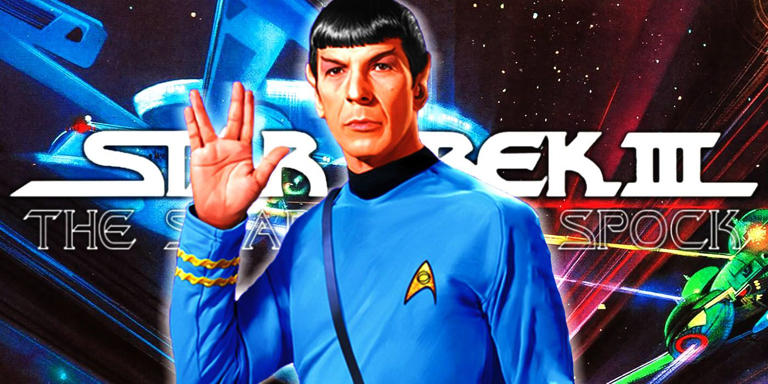
- More to Explore
- Series & Movies
Published May 3, 2024
RECAP | Star Trek: Discovery 506 - 'Whistlespeak'
A body in motion remains in motion.
SPOILER WARNING: This article contains story details and plot points for Star Trek: Discovery.

StarTrek.com
Previously, Dr. Hugh Culber confides in Sylvia Tilly that his experiences on Trill, inhabited by Jinaal Bix , along with their quest to find the thing that created them has been weighing heavily on him. Plus, Paul Stamets hates the unknown; they've always sought out answers together, but he doesn't know how to talk to his partner about any of this. Meanwhile, Adira feels immense guilt for bringing the time bug aboard the ship and trapping the ship in a time loop.
Following her run in with Moll and L'ak on the I.S.S. Enterprise ; Captain Michael Burnham secures the next clue, while L'ak made a bad call and ends up severely wounded. With the clue in Discovery 's possession, Stamets begins running a full chemical analysis of the vial found within the clue.
In Episode 6 of Star Trek: Discovery , " Whistlespeak ," while undercover in a pre-warp society, Captain Burnham is forced to consider breaking the Prime Directive when a local tradition threatens Tilly’s life. Meanwhile, Culber tries to connect with Stamets, and Adira steps up when Rayner assigns them a position on the bridge.

- Paul Stamets
- Sylvia Tilly
- Michael Burnham
- Dr. Hugh Culber
- Dr. Mikaela Suãrez (Culber's abuela)
- Cleveland "Book" Booker
- William Christopher

- U.S.S. Discovery -A
- Halem'no

A polychromatic glow envelops the U.S.S. Discovery -A's Engineering section as Commander Paul Stamets places the vial retrieved from the I.S.S. Enterprise into the scanner for analysis. He is joined by Captain Michael Burnham and Lieutenant Sylvia Tilly, and they all remain frustrated that the clue has stalled them for two days. A hundred other tests have already yielded the same result — the vial's composition is generic and the water inside is pure, inert, distilled… and wet. Burnham notes a scratch on the container and wonders if the damage might indicate that a piece is missing. The modified spectral analysis is completed, but Tilly dejectedly announces that the fluid still reads as distilled water.
The room's illumination is raised to normal levels as the captain begins to pace around the sample. The other clues had words and symbols, yet Stamets assures her that his review of scans from the Enterprise did not reveal signs that anything else was ever affixed to the vial. An attempt to fabricate the map's final two pieces also failed, so solving this clue is the key to finding the next two and reaching the Progenitors' power. Burnham suggests they pivot from chemistry and try history and anthropology — planets where distilled water had cultural or symbolic significance 800 years ago, as well as worlds with severe droughts that would have required rainwater alternatives.
Captain Burnham beams out of Engineering for a scheduled meetup with Dr. Kovich in the sterile confines of the Infinity Room. She assumes he brought her here because there is a new lead on Moll and L'ak, but Kovich sits at a desk and informs her that the U.S.S. Locherer is handling the search. Finding the Progenitors' tech is the Discovery 's mission, and Kovich appears dissatisfied with their lack of progress in tackling the most recent clue. The scientists who hid the technology's location each made their own piece of the clue trail in secret, so Kovich proposes that each individual likely employed their own expertise in the process. He slaps a 20th Century legal pad on the table, having demonstrated his resourcefulness by recovering the scientists' names. The eccentric man tears off a sheet of paper — genuine, not replicated — and hands it over to the captain.
In his office aboard Discovery , Dr. Hugh Culber converses in Spanish with a holographic representation of his abuela . He requests the recipe for their mofongo so he can make it for Paul, but his abuela laughs off the notion. The dish they made was inedible. When Culber would fall asleep, she would throw out their concoction and replicate the food instead. He asks Zora to pause the program and send a message to Dr. Pollard; they might be onto something with this grief alleviation therapeutic, as the brainwave patterning is incredible and the holo of his grandmother is exactly as he remembers her.
Culber's joyful expression fades to uncertainty, and he has Zora restart the program. He mentions his experience with the Trill zhian’tara to her and underscores an indescribable feeling that has emerged in its aftermath. She cradles his face with her hands but cannot help him understand it. They had often spoken about her spiritual practices, so her inability to answer confuses Culber. His abuela speaks up, clarifying that she trained him to be a doctor — a man of science. She questions how he can consider the soul when he has not examined the body, and Culber's features light up with inspiration and comprehension.

"Whistlespeak"
Captain Burnham presents Kovich's list of the scientists' identities and homeworlds to Tilly and Stamets in Engineering. Three names are crossed off — Vellek of Romulus , Jinaal Bix of Trill , and the Terran defector Carmen Cho — leaving Marina Derex of Betazed and Hitoroshi Kreel of Denobula. Burnham bets that the vial is related to Dr. Kreel, whose specialty was designing weather modification towers to generate rain. Denobulan weather towers seed clouds with silver iodide, but the vial's water is free of contaminants. Kreel also did work for other worlds, and especially arid planets would need to extract water from the air at a molecular level. Zora relays that there were 15 M-class worlds on Denobulan trade routes in Kreel's lifetime, but only one — Halem'no — had needed to harvest water in that way. The breakthrough earns a smile from the captain.
Discovery jumps into orbit around Halem'no, where a lush green region stands out from the rest of the planet's bare surface. Long-range scans show a Denobulan weather tower that manufactures rain and emits a low-grade force field to shield the lone habitable region from dust storms. On the Bridge, Commander Rayner is curious as to why Kreel would make such a tower look like a mountain, so the captain turns to Ensign Adira Tal at their science station. Nervous to be assigned to such a prestigious duty, Adira reports that pre-warp and pre-industrial humanoids inhabit the protected area. Given the lack of an electrical grid and surveys which show the storms have increased in severity over the years, they posit that Kreel hid the tower so as not to violate the Prime Directive.
Burnham and Rayner are pleased by Adira's response, and the first officer tells the captain that he honored the ensign's request for more time on the Bridge because he felt they were ready. Adira isn't so sure, but Rayner declares that there's no time like the present. Burnham emphasizes the need to abide by the Prime Directive and conceal their technological capabilities from the locals. An unusual energy field around the tower prevents beaming in or scanning for the next clue, so Burnham states that she'll head to the surface with Tilly while Rayner commands the ship.
A soothing whistle fills Discovery ’s Science Lab, where the captain researches the "whistlespeak" component of the Halem’nite language. Tilly enters, and both officers are now dressed in attire that will allow them to fit in on the planet. Zora can convert the whistlespeak into Federation Standard, but the Halem'nites don't always whistle. They have a phonetic language for day-to-day interactions, but the whistlespeak lets them communicate across great distances. The ability to learn about a society by how its individuals speak sparks enthusiasm from the captain’s inner xenoanthropologist. The Halem'nites don't have any terms to denote societal status or class, but they do recognize three distinct gender identities and prize connection with one another. Amazement washes over her and evokes memories of her time in Dr. T’Prasi's xenolinguistics seminar on Vulcan.

Tilly is thrilled by Burnham;s happiness and comments that they could really use her at Starfleet Academy. The captain asks her friend how things are going there, but their chat is postponed by an update from Rayner. Subcutaneous comms have been loaded into the transport system, and Ensign Tal has included Starfleet's latest retinal tricorder mod. Burnham thanks the commander and beams down alongside Tilly. They materialize in a quiet forest under the cover of night and marvel at the size of the tower constructed by Kreel, which the locals refer to as the High Summit and visit in an effort to commune with their gods.
The two officers begin walking to their destination, and Michael revisits the chat about Starfleet Academy. Tilly just received a message from Cadet Ross, one of her students who had served drinks at the Millennium Celebration. Ross is considering leaving the Academy to accept a position on a cargo vessel, so she wanted Tilly's advice on the matter. Aware that Ross isn't the first cadet to be confronted with this dilemma, the lieutenant is unsure how to respond. Tilly voices her concern that the Academy isn't providing what the cadets need, but she turns her attention to the sound of whistlespeak resonating through the woods. The universal translator deciphers the exchange — travelers from the dust storms are being greeted with hospitality in the direction of Burnham and Tilly's destination.
Back on Discovery , Cleveland "Book" Booker catches up with Dr. Culber in a corridor and expresses his desire to contact the ship's counselor on the Locherer . While Book wants to brief them on Moll and L'ak's full background, Culber insists he must accept there's nothing for him to do right now. The doctor urges Book to focus on something that will allow him to recharge himself, and the former courier playfully ponders whether Culber ever gets tired of having all the answers.
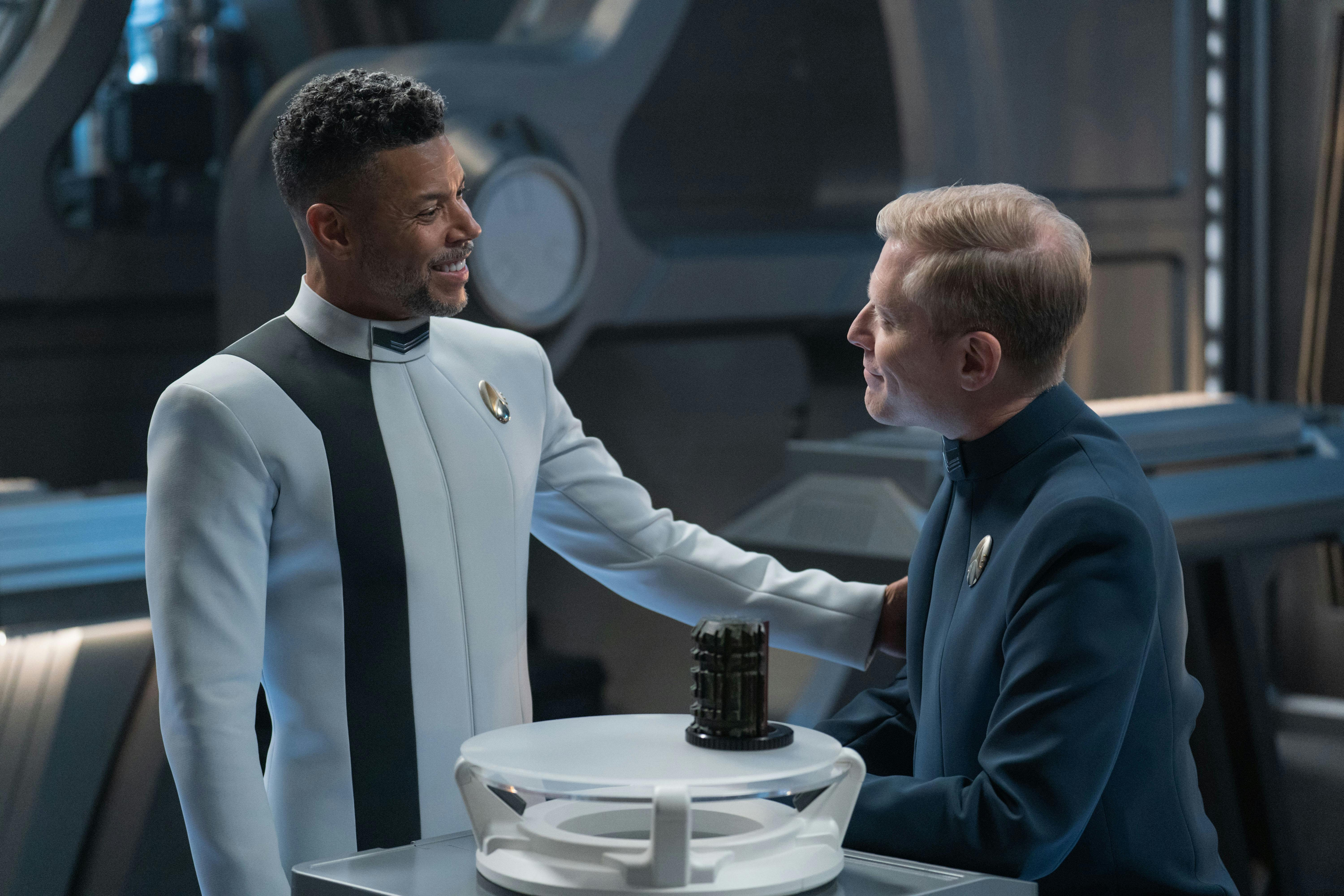
Culber continues to Engineering, where he discovers Stamets toying with the three interlocking clues that have already been recovered. He consults his partner about his desire to do a full neural scan on himself, a revelation which instantly generates a worried look on Paul's face. Culber guarantees that everything is fine and he merely wishes to collect data on the neurological aftereffects of zhian’tara . Stamets realizes Hugh's interest likely stems from real-world symptoms, and the doctor reluctantly confesses that aftereffects might be present. Optimistic about the opportunity to work together — "nothing as romantic as a neural scan" — they express their love through a kiss and resolve to get to work in the morning.
On the surface below, Burnham and Tilly introduce themselves to the group of compeers they had heard from afar. They're greeted warmly, though an elder compeer, Anorah, suffers from a severe cough caused by a dust storm in the drylands. Those gathered proceed toward the High Summit and listen as the elder shares her selfless story of risking time in the storms so that another would not have to take her place. A lengthy drought has been upon them, but the elder points out that only the chosen devout may enter the High Summit's temple to pray for rain. The captain claims that she has come from the east and lived too far away to have witnessed the Summit before.
A friendly voice calls out to the travelers, and a young compeer named Ravah approaches them bearing a smile and holding a lantern. As they welcome the group, their cordiality transforms into concern for the elder, who has begun coughing once again. They head to the healing grove and rest the elder on a wooden bed, but her medicine is nowhere to be found. Alone for the moment, Burnham and Tilly quietly analyze the situation — a sonic percussion wave would easily dislodge the dust in the elder's lungs, but breaking the Prime Directive is not an option. They roll their patient onto her side and administer compressions to her back.
Ravah's father rushes over, and Ravah distributes metal bowls to everyone present. They form a tight circle around the elder and use pestle-like tools on the dishes to generate a high-pitched sound wave. The vibrations rattle nearby surfaces and permit Anorah to cough up dust, but their power overwhelms the captain and renders her unconscious. Burnham awakes a short time later on a bed of her own, pleased to see that the elder has survived. Ravah's father is seated by her side and apologizes for not warning her about the intensity of the sound cure.
Tilly and Ravah join them, and the young compeer shares that their father Ohvahz — the Priest of the Summit — brought them to this settlement after their mother died. They are eager to take their turn and clear dust on the frontlines, though their father is less enthusiastic about the prospect. He is perplexed by Burnham's desire to enter the temple and proclaims that she does not need to do so in order to give thanks to the gods. Ravah eagerly chimes in, stating that one can get in by completing the Journey of the Mother Compeer — a grueling race and test of devotion which makes the gods happy. Only the victor is worthy of going inside the temple and asking for the gods' blessing. To the priest's chagrin, Burnham makes a formal request to partake in the Journey.
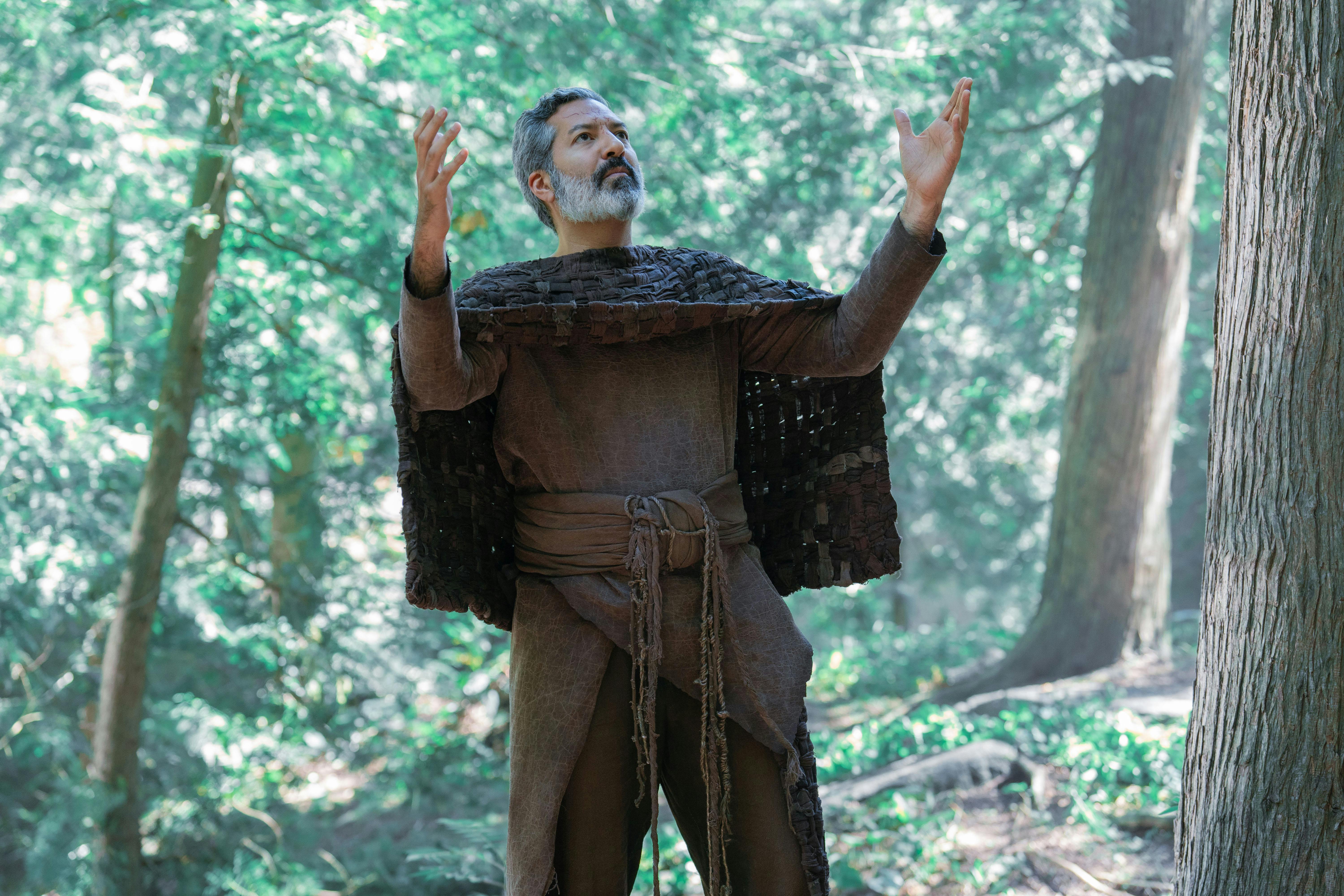
The next morning, numerous participants assemble at the base of the Summit. The atmosphere is festive, and Ravah lightheartedly teases that they are destined to win the race. Their father is clearly concerned about their decision to partake in the event, arguing that they are too young to take the journey. Ravah wears their mother's bracelet in the hopes that she will watch over them, but the priest remains distressed. Tilly steps forward, noting that Ravah's voracity is reminiscent of one of her students "back east." As a teacher, it can be difficult to step back, and she can't imagine how arduous it would be as a parent. Ravah heeds the advice and admires their father, but wants to show him that they can be great too.
Burnham approaches and asks to speak to Tilly for a moment, and the two officers move away to discreetly communicate with Discovery 's Bridge. Rayner gives the stage to Adira, whose scans led them to believe that Halem'no might have had other weather towers in the past. A team of DOTs scoured the surface and located four more towers — over time, their energy distribution matrices fell out of alignment. The High Summit is experiencing the same effect, and that failure is producing the energy field surrounding the tower. Finding the auxiliary control panel would allow them to correct the problem by resetting the components. If they don't fix the technology, those living near the High Summit will perish — just as the settlements surrounding the other towers had. Burnham resigns herself to the truth that one mission has become two.
In Discovery 's Sickbay, Culber sits up on a biobed as Stamets divulges that no biological, chemical, or genetic anomalies appear in the doctor's brain scan. The astromycologist quips that his partner has a perfectly typical, healthy, and — glimpsing the holo of Culber's results — rather handsome human brain. No lasting neurological effects of the zhian'tara are detected, yet Hugh is disappointed that the scans have not provided a physiological cause for what he's feeling. Ever since Trill, he has felt more connected and attuned to something greater than himself. Paul reasons that it's a spiritual quandary, and the doctor nods. Stamets looks on the bright side by highlighting Culber's health and suggests he just enjoy the sensation. He pronounces that the human brain is one of the most complex things in the known universe and places a reassuring hand on the doctor's arm.
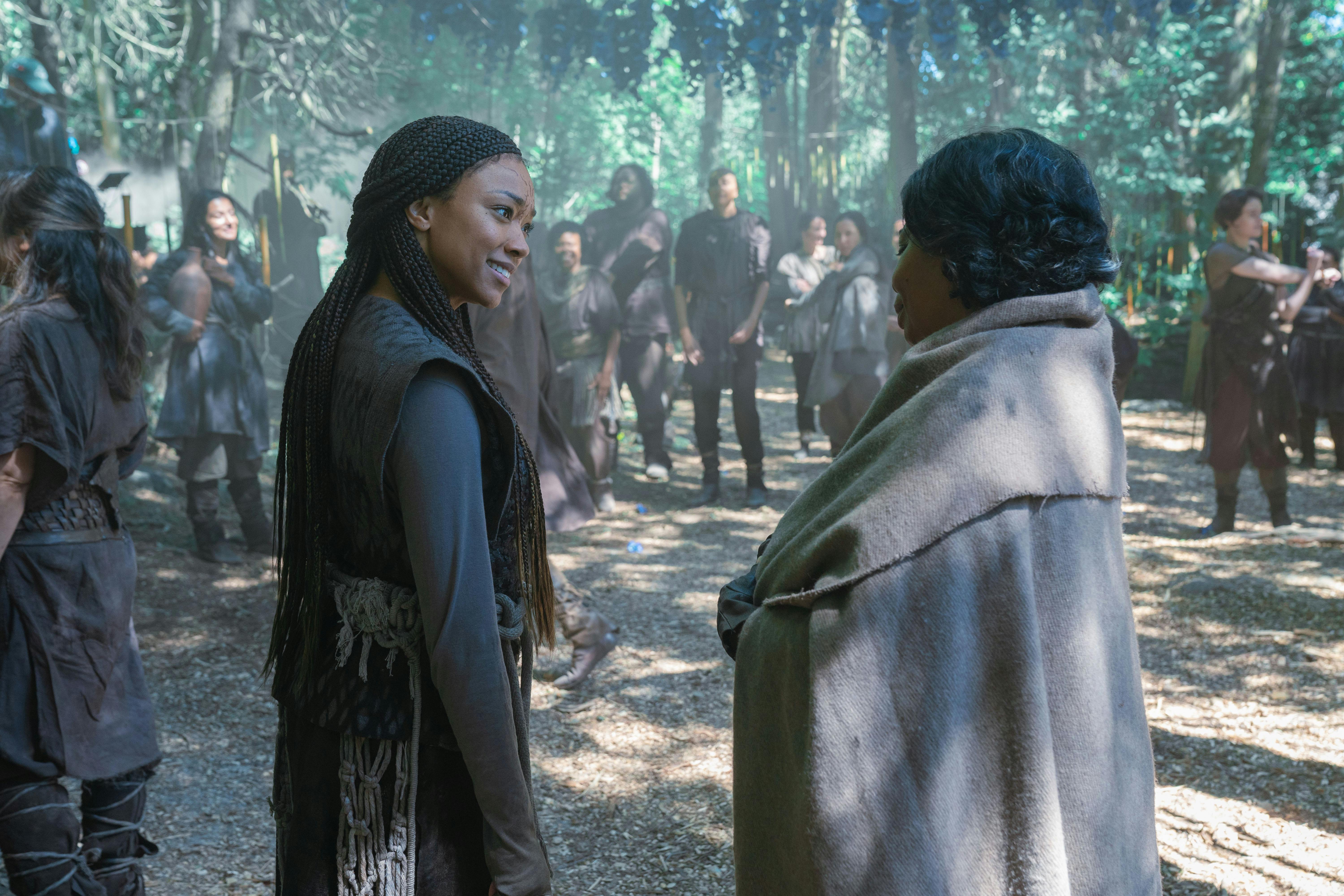
On Halem'no, Captain Burnham approaches Anorah who she helped save the previous night. Unlike those excited by the prospect of the race, this compeer reflects on the journey she and her friend Vohrahli had participated in during their youth. Vohrahli won, but the compeer wonders what it’d be like if she and her friend could be wrinkled old elders together. She shares a laugh with Burnham then observes that one doesn't need to go to the High Summit to be with the gods — they are with them when they do good for each other, just as Burnham saved her — though she accepts Burnham's determination to run.
The captain makes her way over to Tilly at the starting line, and the priest regales the runners with the legend of the Mother Compeer as they are each given a cube to consume. In ancient times, warring Halem'nites lost the favor of the gods and were punished with the dust storms. The Great Mother Compeer rescued her people from thirst by showing the gods the Halem'nites' true selves and venturing out into the storms to find water — as he speaks, several competitors begin coughing and grasping at their throats. The Mother Compeer's lungs filled with dust on her journey home, but she resisted the urge to drink, saved the precious liquid for her children, and died in the process. The gods were so moved that they brought back the rains.
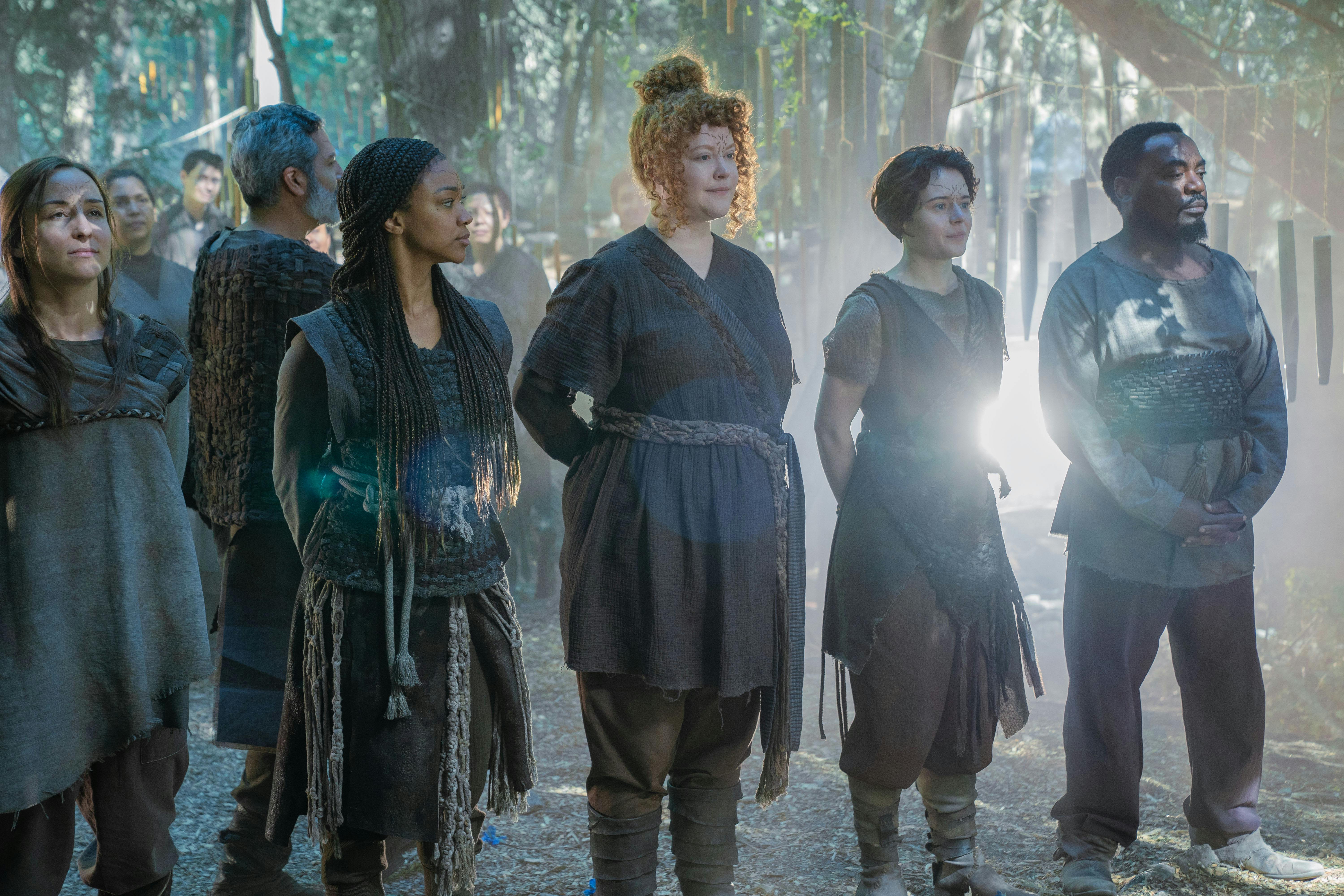
The cube's deleterious effects take hold of Burnham and Tilly, a dry cough and terrible thirst manifesting as compeers fill bowls of temptingly refreshing water on pedestals. The Journey replicates the trial the Mother Compeer endured in a bid to earn the gods' merciful rain. Two compeers can't bear their discomfort any longer and drink from the nearby bowls. Ravah taunts their friends, and the two Starfleet officers take off as the competition begins. The runners jog through the Summit's trails, and several are disqualified when they imbibe from the water dishes they pass along their route.
Slightly winded, Captain Burnham pauses to rest as Tilly circles around her. They press forward, but Michael notices some of the blue moss on the side of the trail has turned yellow. Aware that such a genetic mutation could be caused by radiation leaking out of the tower's malfunctioning control panel, Burnham expects the path of yellow moss to guide her to the controls. In case she's wrong, Tilly — the Queen of Endurance — will stay in the race. The lieutenant is emboldened by the mantra "a body in motion remains in motion," while the captain refreshes herself on the nearest bowl of water.
Further up the Summit, Tilly's exhaustion almost leads to her collapse, but Ravah hurries back to motivate their friend. As the only two runners left, they volley competitive banter back and forth before resuming their jog. Meanwhile, Burnham pursues the yellow moss to a boulder, her retinal tricorder glowing blue as it scans the object's surface. There is a mechanism inside, and pressing the large rock's exterior opens an access panel. The captain alerts Discovery and transmits a holo schematic of the controls to Adira, who informs her that she'll need to rebuild the motherboard without shutting it down. The ensign directs Burnham to a red isolinear chip among a sea of others, and she commences swapping them out.
Creeping ever closer to the finish line, Ravah and Tilly are forced to carry bowls of water to symbolize the relief that tempted the Mother Compeer. They resist the tantalizing liquid, but Ravah is disqualified when they stumble and spill their dish. The priest pleads with them to drink, but Tilly retreats and fills Ravah's bowl with some of her own water. They stand and lock arms, completing the race together as the other compeers clap and cheer them on.
Adira and Discovery 's Bridge crew listen to their captain's updates from orbit, and Rayner addresses the ensign's lingering doubts. He affirms that the time bug was not their fault, encouraging them to tell Burnham the last step in the repair process and "bring it home." The panel's lights shut off when Burnham yanks out the auxiliary power circuit, but the controls hum to life moments later. Adira is elated, and the captain is able to contact Tilly, who has entered the temple with Ravah. There are no signs of the clue, but with the energy field now gone, Discovery can beam a team over.

Tilly's attention is drawn to the voice of Ravah's father, Ohvahz, who comments that their sacrifice will bless Halem'no for many seasons to come. The phrasing startles Tilly, and the young compeer returns their mother's ornate bracelet to their father. As he strains to hold back his tears, Burnham orders Tilly to get out of there. However, when the priest departs the room, the door is sealed and prevents the lieutenant from being transported out. Thick stone walls descend around the Summit's windows, trapping them both inside the temple.
Burnham, Tilly, and Discovery 's Bridge crew attempt to find a workaround, but the walls are solid tritanium and too dense for a transport lock. Rayner pulls up a temple schematic — Tilly is in the vacuum chamber where chemicals rise to mix with air and be shot into the atmosphere. The reaction produces rain, but all the oxygen will be sucked out of the room. Ravah overhears Tilly coordinating with the ship, but the lieutenant remarks that she is praying to the gods. More stone slabs cover the light shining in from above, draping the chamber in darkness. Although Ravah expresses gratitude for Tilly's help in getting here, the Starfleet officer is distressed by her role in the young compeer's impending sacrifice.
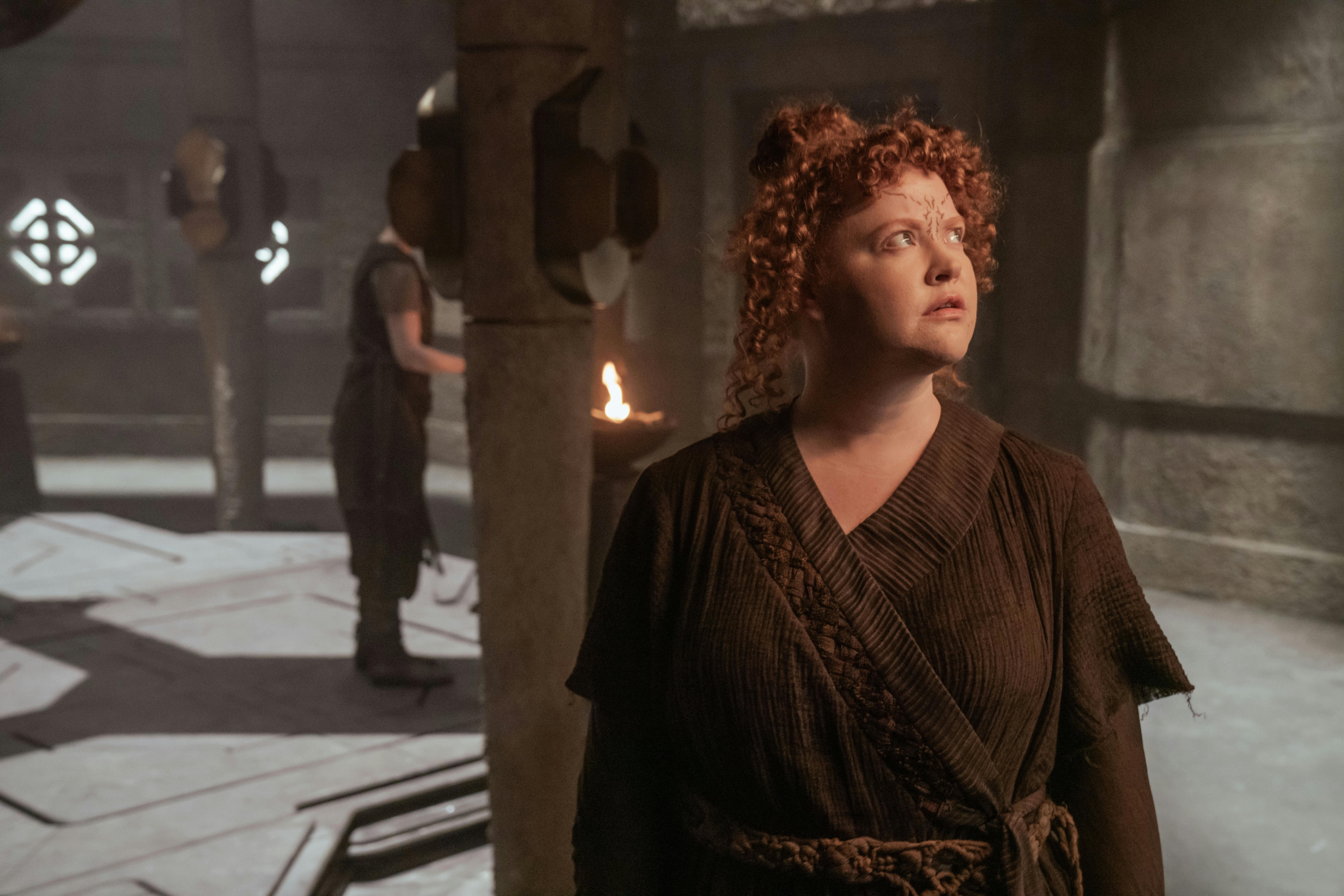
As Ravah takes Tilly to pray by the serenity wall, Captain Burnam has Discovery beam her as close to the temple as possible. A lifesign — Ohvahz — is detected in the control room next to the vacuum chamber, and Rayner raises concern about the Prime Directive. Burnham repeats her order to transport her over. Weakened by the lack of air, Tilly asks Ravah about the symbols carved into the temple's wall. They are numbers which represent the five serenity prayers. Ravah translates the ancient Halem'nese, stroking their hand across the symbols for "one," "two," and "three" — they are in the third Summit. Tilly turns to the markings for "four" and "five," suddenly realizing that the fifth symbol looks very familiar.
Ravah continues to speak about sacrifice, but they withdraw from the wall to kneel on the floor. They cry to themselves, overcome by the reality of death. They admit they do not wish to die, and Tilly moves to comfort them by cradling them in her lap. Tears also pour from the eyes of the priest, who prays to Ravah's mother in the control room and apologizes for failing to protect their child. Burnham materializes behind him, her unorthodox entrance inspiring confusion and fear in the Halem'nite. Urgently needing him to open the door to the chamber, the captain tries to reach him by explaining that they are standing inside of a machine. This gains his attention, and Burnham clarifies that the sacrifices don't bring the rain, the technology does.
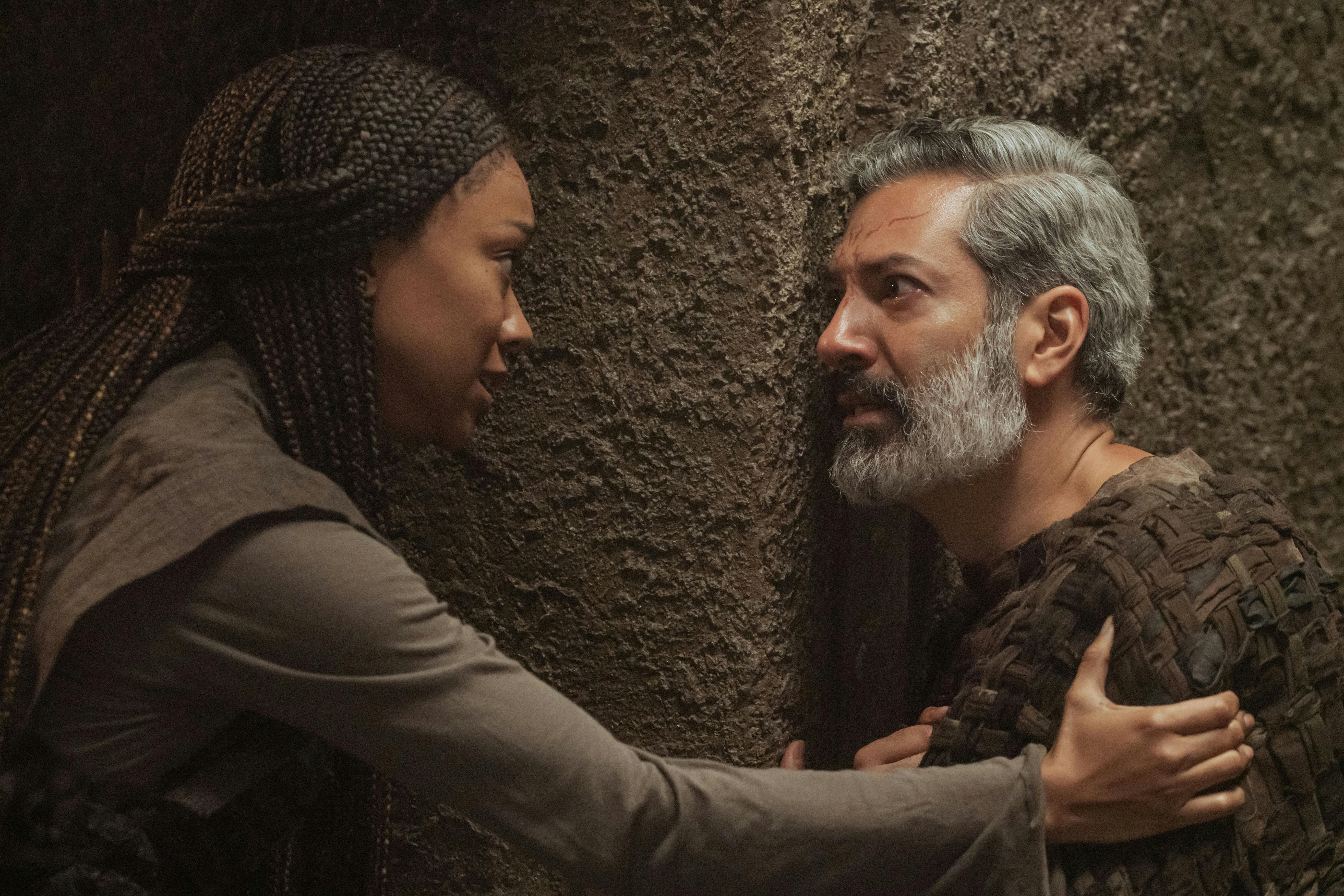
The momentary connection between them evaporates into disbelief, prompting Burnham to hurry to the door and frantically search for the mechanism to activate it. Tilly overhears their discussion through the comm channel and asks Ravah what they remember about their mother. The young compeer hums a song their mother sang to help them sleep. The captain seizes the chance and hums the tune to Ohvahz, who instantly recognizes it. Shocked, he listens to Burnham's words once again — technology allows her to hear his daughter in the other room, and they don’t want to die.
Burnham makes it clear that she is a person, not a god, and she has come from far away to help. The rains will come whether or not Ravah perishes, and she requires his assistance to ensure they live. Ohvahz springs into action, extracting a control handle from the floor and rotating it. The temple is filled with the rumble of stone in motion, and air streams into the vacuum chamber. Burnham and the priest scramble over to their unconscious companions, and Dr. Culber beams in to resuscitate Ravah.

Soon after, Ohvahz marvels at a holographic depiction of Halem'no and is struck by its beauty. Crouching by Ravah, Culber signals that the young compeer will recover. Though relieved, the priest must now confront the Summit's true origins. Burnham details the value the Denobulans place on one another, and much like Halem'no, the massive storms of Denobula required them to build weather towers in order to survive. She supposes the Denobulans felt a connection to the Halem'nites during their travels. The tower will stop functioning eventually, but Burnham will teach them how to maintain it.
The priest is appreciative, but questions whether or not his gods are actually real. The captain counters, stating that nothing she has shown him proves that gods do not exist or that the Journey of the Mother Compeer did not occur. It simply means there are also people from other worlds. Concerned about what to tell his people, Ohvahz is uncertain how they can find a common purpose without the sacrifices. Burnham references Anorah, the woman he healed, who appeared ready to move beyond the sacrifices. Beliefs can evolve, and maybe more Halem'nites are prepared to understand that. Dr. Culber informs them that Ravah will wake soon, and their father moves to put their mother's bracelet back on his child before they stir.
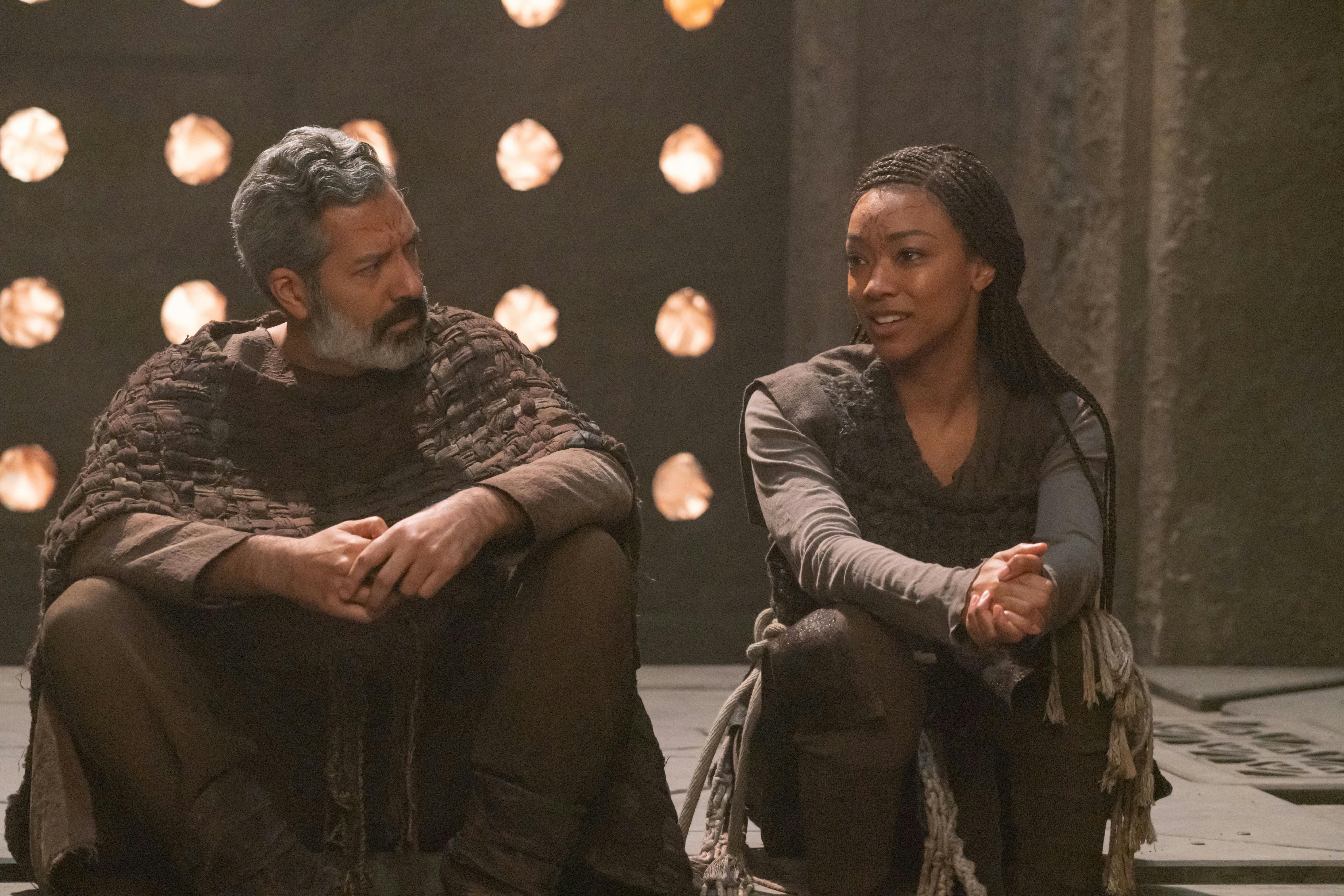
Burnham converses with Tilly about her Prime Directive violation, but the lieutenant has insight that will improve the captain's mood — the symbol for "five" on the temple's Serenity Wall matches the scratch mark on the vial of distilled water. The next clue must be in Tower Five! They turn as Ravah calls for their father, who settles their concern about defying their faith by saying, "Perhaps devotion means being able to hear when the gods tell us something new." He boasts about the pride he feels for them, and they embrace. A roar of thunder clatters above them, and a wealth of rain falls on the entire region.
Parked in a shuttle aboard Discovery , Book tests his piloting skills in a flight simulation. The program ends when Culber enters carrying two covered dishes, the doctor having brought his grandmother's mofongo con pollo al ajillo — replicator fresh. They take a seat to dine, and Book savors the delicious smell. Culber brings up Book's joke that the doctor has all the answers and vows that he does not. As they both enjoy the food, Culber notes that he's either having a "spiritual awakening" or seeing a truth he's always known. Book believes it sounds kind of wonderful and asks why Hugh is upset that Paul may never understand this feeling. Humans have an odd quirk — a tendency to consider something to be less meaningful if it's just for yourself. Book recalls Michael dealing with a similar struggle, and Culber can see that the former courier misses what he had with the captain. It's unknown whether the two can get their relationship back.
Having recovered the next clue from Tower Five, Burnham and Tilly lock it into the map alongside the three previous pieces. The latest device had a metal card attached featuring a Betazoid text inscription. Stamets is currently analyzing the writing, so the two officers take a breather in Engineering and theorize about what Dr. Kreel had intended to teach them with his clue. The scientists couldn't have known the weather tower would lead the Halem'nites to sacrifices, but the lesson may reside within the notion that technology is a massive responsibility. When Discovery finds the Progenitors ' creation, its crew will need to be incredibly careful. Lieutenant Christopher contacts them over the comm system, relaying that the U.S.S. Locherer just found Moll and L'ak. Admiral Vance wants Discovery to jump there immediately. As the starship leaves orbit and activates its spore drive, the serene sound of whistlespeak echoes out from the planet.

- Written by Kenneth Lin & Brandon Schultz
- Directed by Chris Byrne
Get Updates By Email
Jay Stobie (he/him) is a freelance writer, author, and consultant who has contributed articles to StarTrek.com, Star Trek Explorer, and Star Trek Magazine, as well as to Star Wars Insider and StarWars.com. Learn more about Jay by visiting JayStobie.com or finding him on Twitter, Instagram, and other social media platforms at @StobiesGalaxy.
Star Trek: Discovery Seasons 1-4 are streaming exclusively on Paramount+ in the U.S., the UK, Canada, Switzerland, South Korea, Latin America, Germany, France, Italy, Australia and Austria. Seasons 2 and 3 also are available on the Pluto TV “Star Trek” channel in Switzerland, Germany and Austria. The series streams on Super Drama in Japan, TVNZ in New Zealand, and SkyShowtime in Spain, Portugal, Poland, The Nordics, The Netherlands, and Central and Eastern Europe and also airs on Cosmote TV in Greece. The series is distributed by Paramount Global Content Distribution.

Star Trek: Why The Romulans Were Bald In The J.J. Abrams Movies
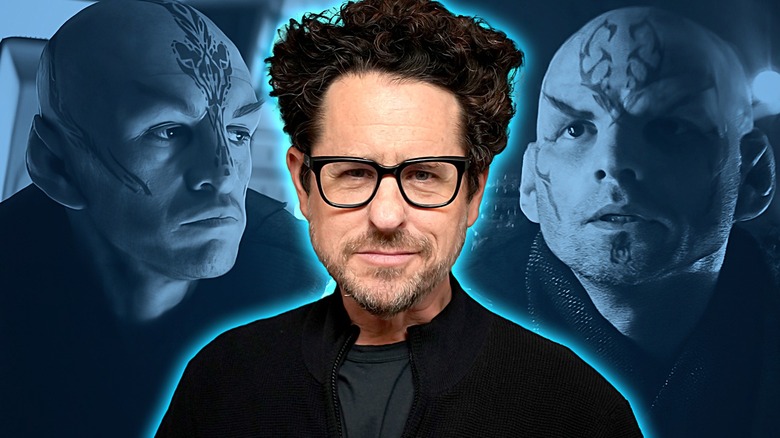
As J.J. Abrams took the helm of the "Star Trek" franchise, there were plenty of twists and tweaks he applied to the point in the timeline when James T. Kirk (Chris Pine) met his green-blooded BFF-to-be, Spock (Zachary Quinto). One detail involved Romulans, the biological cousins of Vulcans, who shared similar eyebrow styles and pointy ears. In Abrams' "Star Trek," the species have a considerably different appearance from what we had seen in the shows previously. Led by Eric Bana's Nero, any Romulan on-screen was bald, bearing facial and head tattoos. While it might appear like a subtle and interesting detail applied to the Kelvin timeline of "Star Trek ," the truth is that the design was so that audiences could tell them apart from Vulcans.
It is certainly a logical approach to making it easier for casual audiences to decipher which pointy-eared alien to keep an eye on. According to TrekMovie.com , back when they were trying to snag any rumor they could in their tractor beam before the film's release, it was confirmed that all actors playing Romulans — whether Bana, his on-screen number two played by Clifton Collins Jr., or background performances — had to give themselves a trim. It was slightly before the film's release that a reason was also established for the Romulan's tattoos, which were backed up by a heartbreaking expansion on events set before the film.
A clear-cut explanation revealed the Romulans new look
Before the 2009 film's release, IDW Publishing released a four-issue comic book series called "Star Trek: Countdown," exploring the events that led Nero to get his revenge on the original Spock (Leonard Nimoy). As explained in "Star Trek," Nero's blind rage for the legendary Vulcan is born out of the destruction of Romulus, for which he holds Spock responsible. As captain of the mining vessel, the Narada, Nero and the rest of his crew shaved their heads and inked themselves as a sign of mourning for losing their home planet.
As explained in "Star Trek: Countdown #3," a Romulan tradition during a time of loss saw mourners paint symbols onto their skin, and their gradual fading would signify the passing of the sorrow felt as their own life carried on without those who were lost. Nero and his crew, however, made the tattoos permanent, believing that their lives were over when they lost their home and family. As a result, the ink would never fade.
It's an excellent little detail that "Trek" fans may only have been aware of if they snatched up the books before the film's release. Also, along with "Star Trek: Picard," which expanded on the untold truth of "Star Trek's" Romulans and the failure of the planet being saved, it certainly paints an even stronger argument as to why Eric Bana's Nero is the most dangerous villain in "Star Trek" history .

Destruction of Vulcan
- View history
The destruction of Vulcan took place on stardate 2258 .42 after the Romulan Nero drilled to the planet's core where he detonated red matter , causing the planet to implode. A Starfleet task force attempted to stop the attack, but were no match for Nero's starship the Narada .
- 2 The battle
- 3 Aftermath
- 4.1 Appearances
- 4.2 References
- 5 External link
Prelude [ ]
129 years in the future, a supernova had completely destroyed the Romulan homeworld, Romulus , despite the best efforts of Federation ambassador Spock to prevent it. A full-scale Federation rescue effort had been planned but was politically controversial even before the rescue armada was lost in the Attack on Mars , at which point the effort was abandoned. ( PIC : " Remembrance ", " Maps and Legends ") Spock was able to collapse the supernova into a singularity using a red matter device, before any other worlds could fall victim, but an enraged Romulan captain named Nero intercepted Spock's ship and threatened to destroy him.
Before he could do so, however, the singularity's gravity well dragged both ships inside, with Nero's vessel, the Narada being thrown back to the year 2233 , while Spock's craft, the Jellyfish was pulled in a few seconds later and arrived in the year 2258. The Narada had again intercepted the Jellyfish however, having waited twenty-five years to do so. Nero then captured Spock and marooned him on the nearby planet Delta Vega , so that he would be forced to witness Nero's revenge for the destruction of his homeworld. ( Star Trek )
The battle [ ]
Afterward, the Narada arrived at Vulcan and deployed a high-powered plasma drill in Vulcan's upper atmosphere to drill a huge shaft to the core of Vulcan. The Vulcan High Command sent out a distress call which led to a Federation task force to pursue and the assess the situation. With much of Starfleet's resources occupied in the Laurentian system , many ships were partially-manned by Starfleet Academy cadets. The Narada initially detected seven starships approaching, though it is known that ten Federation ships were launched.
When they arrived, however, the ships proved no match for the advanced weaponry of the Romulan ship, and the fleet was destroyed in short order. One starship, the newly-launched USS Enterprise , had arrived later than the others (owing to a minor mistake by its rookie helmsman ) and nearly collided with the debris field made up of wreckage from the other starships.

The aftermath of the rout
Nero witnessed the arrival of the new starship and was prepared to destroy the Enterprise , when he realized just which ship it was, and that this reality's Spock would be on the vessel. He ordered the captain of the Enterprise , Christopher Pike , to surrender himself and come on board the Narada , which he agreed to do. Before he went to the Narada however, Pike dropped an assault team comprised of James T. Kirk , Sulu and Chief Engineer Olson onto the Narada's drill platform . Interference from the drill made beaming impossible, so Pike had his assault team use space suits and parachutes to reach the platform.

The Enterprise and the Narada face off over Vulcan
In an effort to achieve total surprise over the Romulans, Olson delayed in deploying his parachute until the last possible instant. Unfortunately, Olson badly miscalculated his descent and he crashed into the platform, fell off the side and was incinerated by the drill's energy discharge. Kirk and Sulu were suddenly left at a disadvantage since Olson had been carrying the explosive charges with which they intended to destroy the platform.
Two Romulan crewmembers emerged from the drill and hand-to-hand combat began between them and the Starfleet officers. The fight ended when one of them was burned to death by flames from an exhaust outlet, while the other was impaled and thrown off the side of the platform. Using captured disruptor rifles, Kirk and Sulu shot at the mining platform's machinery until it ceased functioning.

Starfleet officers land on Nero's drill
Unfortunately, their efforts came too late; the Narada had already reached the planet core. Nero then ordered a bomb made up of red matter from the Jellyfish to be fired into the planet's core. When it detonated it created an artificial singularity within the planet. Upon hearing of this, and that the entire planet would be obliterated within a matter of minutes, acting captain Spock sent a largely futile evacuation order to the planet and beamed himself down to retrieve the Vulcan elders (including his parents) who were tasked with preserving Vulcan's cultural heritage and wisdom. Since the elders convened inside the katric ark , direct communication and transporter functions were impossible.
Not all of the elders escaped as the surface began to collapse and among the casualties was Spock's mother, Amanda Grayson . Seconds later the planet completely imploded into the singularity, leaving no trace of its existence or that of its six billion inhabitants. ( Star Trek )
Aftermath [ ]

Nero interrogates and tortures Captain Pike
The battle concluded with the destruction of the planet and the death of its six billion Vulcan inhabitants. The Narada had suffered only minor damage and the loss of two crewmen. Nero was also able to detain Captain Pike as a prisoner and information source. Through the use of a Centaurian slug , Nero gained pertinent knowledge of Federation defenses from Pike that would later be utilized in his follow-up attack against Earth .
The deep emotional effects Spock suffered as a result of the destruction of Vulcan were later used to justify relinquishing his command of the Enterprise to its temporarily promoted first officer , Jim Kirk.

The elder Spock on New Vulcan
In the wake of the devastation, Ambassador Spock was able to locate a suitable planet to establish a colony and assist the estimated 10,000 remaining Vulcans in restoring their way of life. The colony was simply named New Vulcan . ( Star Trek ; Star Trek Into Darkness )
The destruction of Vulcan resulted in Section 31 taking a much more active role in defending the Federation. They began to aggressively explore uncharted regions of the galaxy. Along the way, they recovered the SS Botany Bay carrying 85 genetically augmented humans in cryosleep. Admiral Alexander Marcus then awakened their leader, Khan Noonien Singh believing his superior intelligence would aid them. Marcus threatened to kill Khan's 72 surviving crew members, blackmailing him into helping Section 31 design advanced weapons and warships, among them the Dreadnought -class USS Vengeance . ( Star Trek Into Darkness )
Appendices [ ]
Appearances [ ].
- Star Trek (First appearance)
References [ ]
- Star Trek Into Darkness
- Star Trek Beyond
External link [ ]
- Destruction of Vulcan at Memory Beta , the wiki for licensed Star Trek works
- 2 ISS Enterprise (NCC-1701)
Den of Geek
Star Trek Just Pulled Off a Huge Call Back to a Beloved Enterprise Character
Star Trek: Discovery season 5 digs deep into The Original Series lore in an episode full of references to "The Paradise Syndrome."

- Share on Facebook (opens in a new tab)
- Share on Twitter (opens in a new tab)
- Share on Linkedin (opens in a new tab)
- Share on email (opens in a new tab)
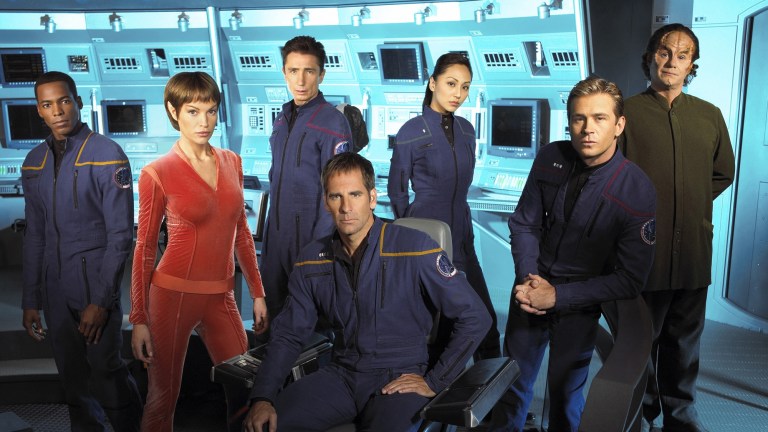
This Star Trek: Discovery article contains spoilers.
Although Star Trek: Discovery season 5 is focused on a season-long quest for ancient secrets from before the dawn of history, there have also been a few episodes that have been almost standalone in structure. From the time loop in “Face the Strange” to the return of the ISS Enterprise in “Mirrors,” Discovery ’s final seasons has episodic stories, woven into the bigger arc. And, out of all of season 5, episode 6, “Whistlespeak,” is probably the most standalone of the bunch.
In order to retrieve the latest clue to the Progenitor tech, the USS Discovery jumps to the planet Halem’no, a pre-warp planet. Here, Burnham and Tilly have to go undercover to not only find the clue, but also, repair some concealed technology. Along the way, Discovery pays homage to The Original Series , the prequel series Enterprise , and beyond. Here are the biggest Star Trek easter eggs and references in the episode…
Weather Towers
Throughout all of Star Trek , or at least the time of The Voyage Home , there’s been the strong suggestion that the weather on Earth, and other Federation planets, is controlled by low-key terraforming technology. In “Whistlespeak,” Burnham and Tilly have to fix a weather tower that is malfunctioning on a pre-warp, Prime Directive-protected planet. This exact mission hasn’t happened before, but it is reminiscent of several Trek episodes from the past…
Ad – content continues below
Going Undercover With an Indigenous Culture
The conceit that Burnham and Tilly have to blend in with a pre-warp civilization has several precedents in other Star Trek series and films. In The Original Series episodes “Pattern of Force,” “Return of the Archons,” “A Private Little War,” and “The Paradise Syndrome,” the crew has to infiltrate planets and pass themselves off as natives. Ditto The Next Generation episode “Who Watches the Watchers?” and the beginning of the feature film Insurrection . Burnham, Owo and Captain Pike also went undercover in a pre-warp civilization in the Discovery season 2 episode “New Eden.” Then, the entire Strange New Worlds gang, including Pike, Spock, and La’an all went undercover in the series premiere of that that show, also titled “Strange New Worlds.”
Finally, the very first glimpse of Michael Burnham ever happens near the start of the first Discovery episode from 2017, “The Vulcan Hello.” And in that episode, Captain Georgiou and Michael Burnham are helping save a pre-warp civilization from a drought without being detected. So, in Disco’s first season and its last, Burnham is on a very similar mission. At least once, anyway.
Subcutaneous Comms
Burnham and Tilly also rock both subcutaneous — under the skin — communicators, as well as tricorders embedded into their eyes. The retinal tricorders are new, but Kirk and Spock both had subcutaneous transponders put into their arms in the episode “Patterns of Force.”
The scientist who created the weather towers for the Halem’nites was named Hitoroshi Kreel, a Denobulan. Though we never see him on screen, we know, generally, some basic features of what Denobulans look like. The beloved character of Dr. Phlox in the series Enterprise was a Denobulan, and it was in that series that nearly all the lore of the planet Denobula was established, even though the planet was never seen on screen. Outside of Enterprise , we’ve seen Denobulans in Lower Decks , Prodigy , and briefly in Strange New Worlds Season 2. But, despite being mentioned in this Discovery episode, no Denobulans appear.
Burnham’s Job
While it’s easy to forget what Burnham trained to do for Starfleet, this episode reminds us of the fact that in season 1, it was established that in both Starfleet and at the Vulcan Science Academy, Burnham studied xenoanthropology. She’s actually perfect for away missions like this because of her anthropological background, unlike say, several other Starfleet captains who frequently would go on missions like this.
“We could really use you at”
Ever since season 4, Tilly has been teaching at Starfleet Academy, which, for now, is located somewhere at Federation HQ. Tilly telling Burnham she wants her to teach there too is interesting, and has some precedent in previous Star Trek lore. When Spock was teaching at Starfleet Academy, in The Wrath of Khan , he brought Kirk in to help out at the beginning of the movie. Because Tilly and Burnham are both from the 23rd Century initially, it’s not too nuts to think of them both teaching at Starfleet Academy at some point in the future, much like their classic-era colleagues across space and time.
Paradise Syndrome: Reloaded
Overall, the story of “Whistlespeak” feels like a modern update of tricky TOS episode, “The Paradise Syndrome.” In that episode, Kirk lost his memory, and became part of a tribe of Native Americans who lived on a planet that was not Earth. Progressive stuff for 1968 maybe , but less than great or thoughtful now. However, the sci-fi premise of “The Paradise Syndrome” was fantastic even if the politics were iffy: A device that was placed on the planet by an advanced alien race—designed to protect the people of the planet—malfunctions and gains religious significance. This is exactly what happens with the weather stations on Halem’no, and, just like Kirk and Spock had to go back into the obelisk in TOS to save the native population, Burnham and Tilly have to do the same thing in this Discovery episode.
Get the best of Den of Geek delivered right to your inbox!
Interestingly, this “Paradise Syndrome,” connection goes even deeper when you realize that “The Preservers,” mentioned in that episode, were the first indication that an advanced humanoid species seeded several planets with humanoid lifeforms. So, without “:The Paradise Syndrome,” you kinda don’t have the TNG episode “The Chase,” and without that, you certainly don’t have Discovery season 5’s epic search for the Progenitor tech, which goes all the way back to 1993, or 1968, or millions of years in the past, depending on your point of view.

Ryan Britt is a longtime contributor to Den of Geek! He is also the author of three non-fiction books: the Star Trek pop history book PHASERS…

IMAGES
VIDEO
COMMENTS
Ni'Var, formerly Vulcan, was an inhabited M-class planet in the Vulcan system of the Alpha Quadrant. Though the planet had no moons, it did form a binary pair with T'Khut and was considered its sister planet. It was the homeworld of the Vulcans, a warp-capable humanoid species. (TOS: "The Man Trap", "Amok Time"; TAS: "Yesteryear"; Star Trek: The Motion Picture; VOY: "In the Flesh"; ENT ...
Nimoy demonstrating the Blessing gesture he said was the inspiration for the Vulcan salute. The Vulcan Mister Spock first appeared in the original 1965 Star Trek pilot, "The Cage", shown to studio executives.Show creator Gene Roddenberry revealed in 1964 that he wanted an alien as part of the ship's crew, but knew that budget restraints would limit make-up choices.
In the "Star Trek" universe, the star 40 Eridani A (alias HD 26965) has long been canon as the sun of Vulcan, the home world of the franchise's favorite pointy-eared science officer, Mr. Spock.
In Star Trek lore, Vulcan is the home of logic, learning and the deeply beloved first officer Mr. Spock. While Vulcan is fictional, the star system it belongs to-40 Eridani-is very real. It's located only 16.5 light-years away from Earth and its primary star can be spotted with the naked eye.
Star Trek. The Vulcans, or Vulcanians, [1] were a warp-capable humanoid species from the planet Vulcan. They were widely renowned for their strict adherence to logic and reason as well as their remarkable stoicism. In 2161, their homeworld became a founding member of the United Federation of Planets.
The Vulcan system, also known as the 40 Eridani system, was an inhabited star system located in the Alpha Quadrant. This was a trinary star system. Several planets, including Delta Vega and Ni'Var, orbited the star 40 Eridani A. Neighboring the Andorian system, it was located sixteen light years from the Sol system. (ENT: "The Andorian Incident", "Home", "Daedalus"; Star Trek; DIS: "Magic to ...
For starters, the planet Vulcan changed its name to Ni'Var, which is now the shared homeworld of the Vulcans and Romulans. Star Trek: Discovery season 3, episode 7, "Unification III", is a monumental hour that follows up major plot lines from Star Trek: The Next Generation, J.J. Abrams' 2009 Star Trek movie, and Star Trek: Picard.
While Vulcan, the home planet of Spock, is one of the most well-known worlds in science fiction, the planet is entirely fictional. However, the star system it belongs to in "Star Trek" is for real.
The beloved "Star Trek" character hailed from the made-up planet Vulcan around the very real star 40 Eridani A, just 16 light years from Earth.In 2018, astronomers discovered an actual planet ...
Star Trek creator Gene Roddenberry wrote in 1991 that 40 Eridani is Vulcan's home star. 40 Eridani is a triple star system, and the newfound planet orbits the system's primary star, just as ...
Doctor Who honored the real-world origin of the planet Vulcan by giving its name to a hostile world with bubbling lakes of poisonous mercury; one tie-in comic actually suggested this colony was indeed situated on a planet in the solar system, but that's been ignored by the wider canon. Meanwhile, in Star Trek Vulcan is an arid and warm world ...
Astrophysicists just found a planet orbiting the star HD 26965, 16 light years away from Earth. ... See, HD 26965 also goes by 40 Eridani A—the star orbited by Spock's homeworld in Star Trek ...
Real-Life 'Planet Vulcan' Orbits Sun Featured in 'Star Trek'. An artist's depiction of what the newly discovered planet orbiting 40 Eridani A, a star made famous by the series "Star Trek," might ...
And, Henry added, Trek fans might recognize the star HD 26965 by its other moniker... 40 Eridani A. Henry, whom the UF article reports collected precise brightness measurements of the star at TSU's automated observatory needed to confirm the presence of the planet, stated, "Vulcan was connected to 40 Eridani A in the publications Star Trek 2 by James Blish (Bantam, 1968) and Star Trek Maps ...
A new analysis rules out the suspected planet Vulcan. NASA/JPL-Caltech SHARE. Star Trek fans knew they would lose the planet Vulcan someday in a fiery implosion at the hands of the Romulans—but ...
Vulcan (for the uninitiated) is the planet in the " Star Trek " universe which orbits the actual star 40 Eridani A in the constellation of Eridanus. When a research team thought they had ...
The 40 Eridani star system is composed of three stars. Vulcan orbits the primary star, and the two companion stars "would gleam brilliantly in the Vulcan sky," they wrote in their 1991 letter. "Vulcan is the home planet of Science Officer Mr. Spock in the original "Star Trek" Sci-Fi series," says Henry. "Spock served on the ...
Later, 40 Eridani became the canon Vulcan star system featured in a handful of episodes of Star Trek: Enterprise. In real life, 40 Eridani is a triple star system located about 17 light-years from ...
Star Trek's planet Vulcan found to not be a planet after all. A large international team of space scientists has discovered that the detection of an exoplanet orbiting the star 40 Eridani was made ...
Gene Roddenberry, the creator of Star Trek, published a letter in Sky and Telescope magazine in July 1991 where he formally identified the star that the fictional planet Vulcan would orbit in real life. Roddenberry and members from the Harvard-Smithsonian Center for Astrophysics identified the star 40 Eridani A as the would-be planet Vulcan host star.
24 hours. Vulcan from orbit in 2154. Vulcan (also known as Vulcan / Vulcanis A II, Nevasa II or 40 Eridani A II) is a planet, the second planet in the 40 Eridani star system, in orbit of the star 40 Eridani A. A class M desert planet, Vulcan is inhabited by the Vulcan civilization, who refer to their world as T'Khasi, Minshara or Ti-Valka'ain .
In the Star Trek: Deep Space Nine Companion (p. 557), Ronald D. Moore mentions that the Star Trek: Deep Space Nine writers toyed with making Vulcan the planet that was conquered by the Dominion in "In the Pale Moonlight". However, they decided to go with Betazed, as Vulcan carried "too much weight."
The Star Trek franchise may not have a planet-destroying Death Star, but entire worlds being annihilated in Star Trek is still surprisingly common. ... J.J. Abrams' Star Trek (2009) famously destroyed Romulus and Vulcan, altering the trajectory of the Federation's future and the lives of Captain James Kirk (Chris Pine) and Spock (Zachary ...
Star Trek III revealed in this moment, he transferred his "katra" -- the Vulcan soul, ostensibly -- into McCoy's mind. The katra and his body were then supposed to be taken to the planet Vulcan.
Most extrasolar planets in fiction are similar to Earth—referred to in the Star Trek franchise as Class M planets—and serve only as settings for the narrative. One reason for this, writes Stephen L. Gillett [Wikidata] in The Greenwood Encyclopedia of Science Fiction and Fantasy, is to enable satire. Nevertheless, there are also many fictional planets that differ significantly from Earth.
Captain Burnham presents Kovich's list of the scientists' identities and homeworlds to Tilly and Stamets in Engineering. Three names are crossed off — Vellek of Romulus, Jinaal Bix of Trill, and the Terran defector Carmen Cho — leaving Marina Derex of Betazed and Hitoroshi Kreel of Denobula. Burnham bets that the vial is related to Dr. Kreel, whose specialty was designing weather ...
Also, along with "Star Trek: Picard," which expanded on the untold truth of "Star Trek's" Romulans and the failure of the planet being saved, it certainly paints an even stronger argument as to ...
Here's everything we know about Season 3 of 'Star Trek: Strange New Worlds,' including cast, plot, renewal news and more! We'll add the release date, trailer, guest stars as soon as they're announced.
The destruction of Vulcan took place on stardate 2258.42 after the Romulan Nero drilled to the planet's core where he detonated red matter, causing the planet to implode. A Starfleet task force attempted to stop the attack, but were no match for Nero's starship the Narada. 129 years in the future, a supernova had completely destroyed the Romulan homeworld, Romulus, despite the best efforts of ...
Star Trek: Discovery season 5 digs deep into The Original Series lore in an episode full of references to "The Paradise Syndrome." Share on Facebook (opens in a new tab) Share on Twitter (opens in ...